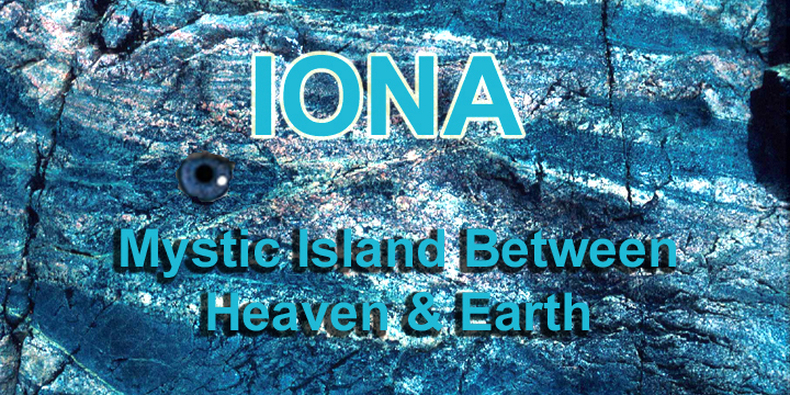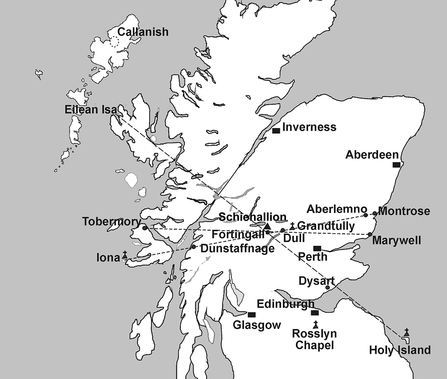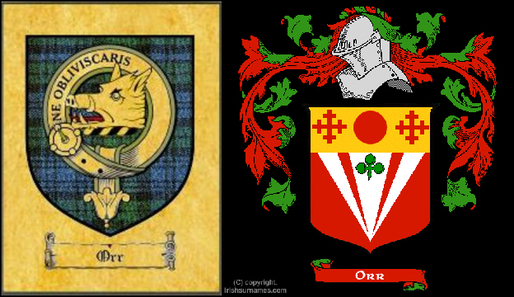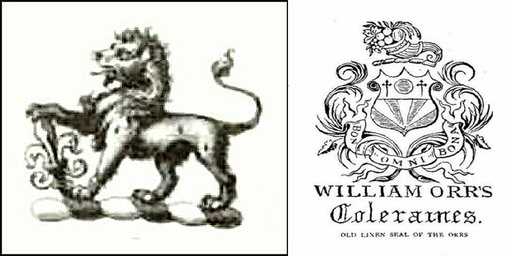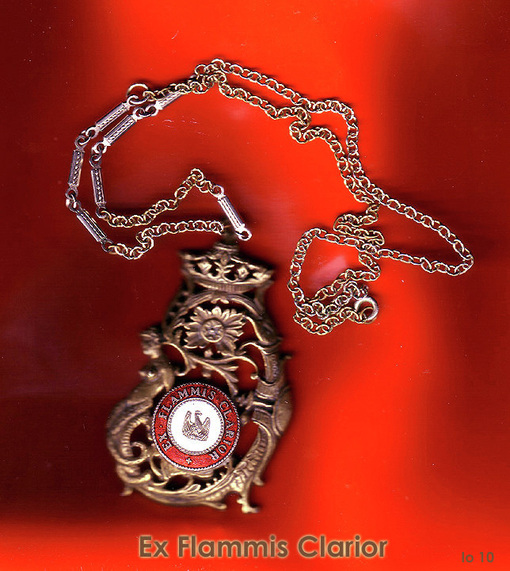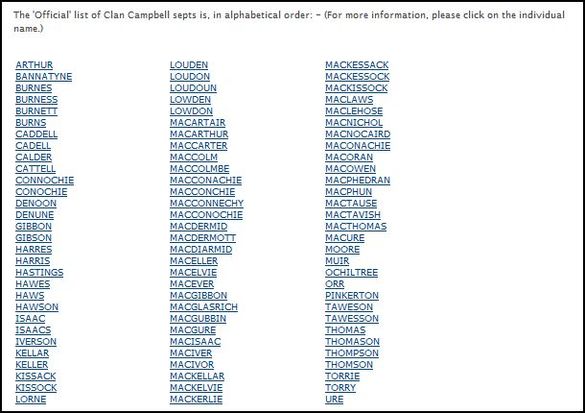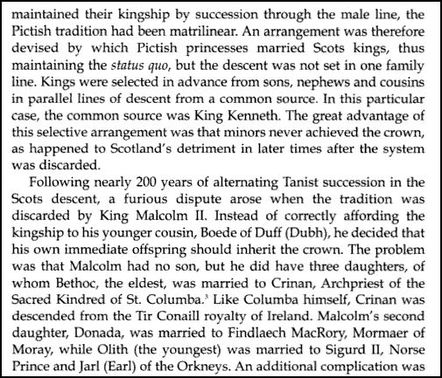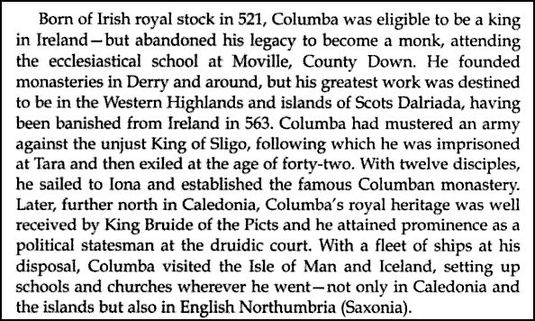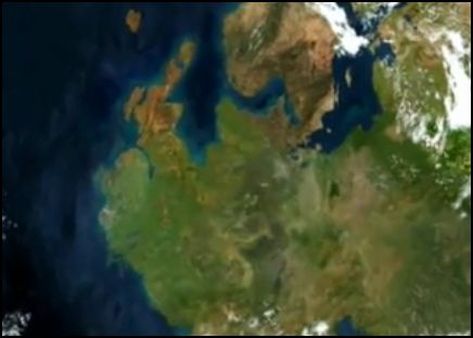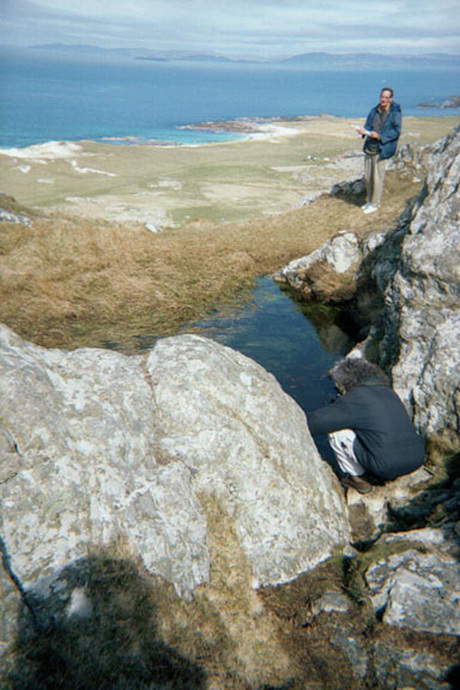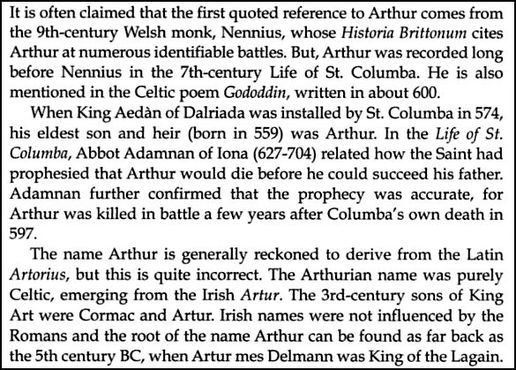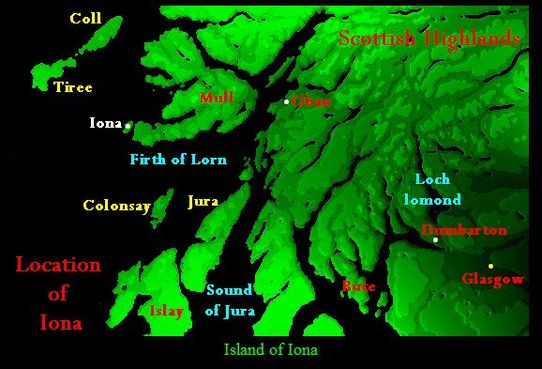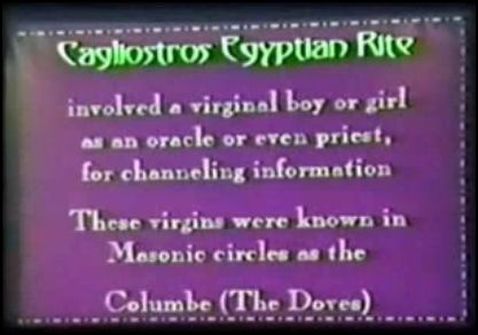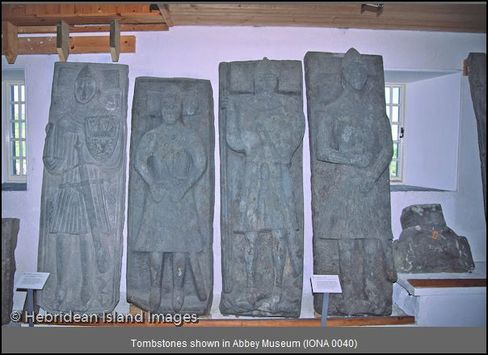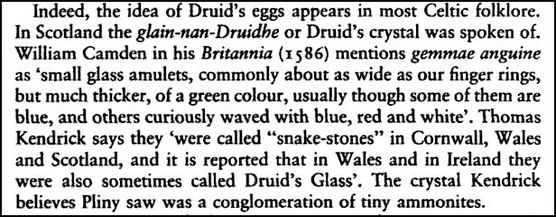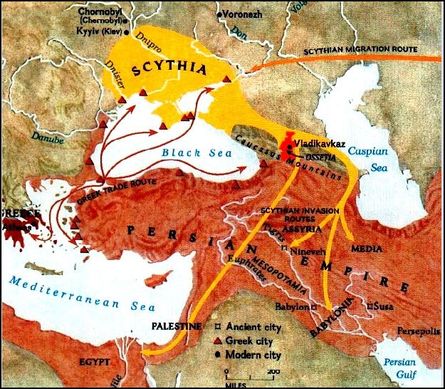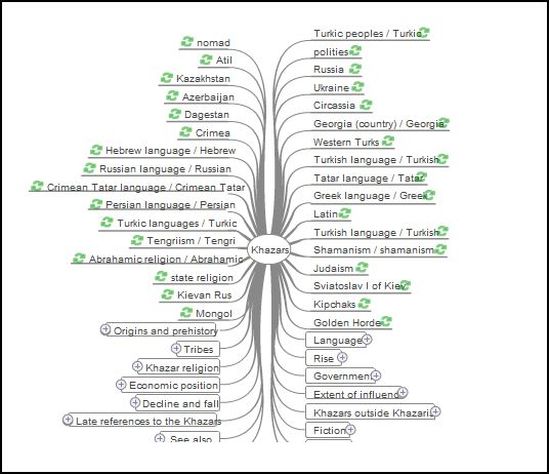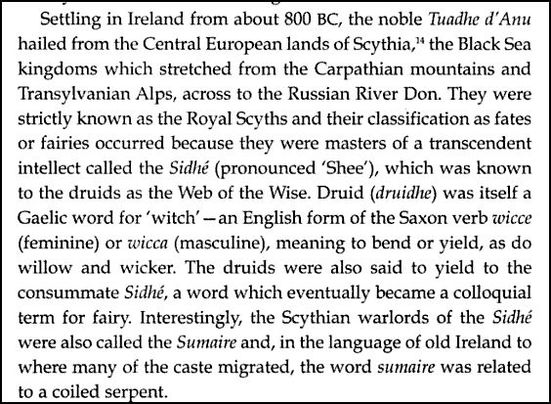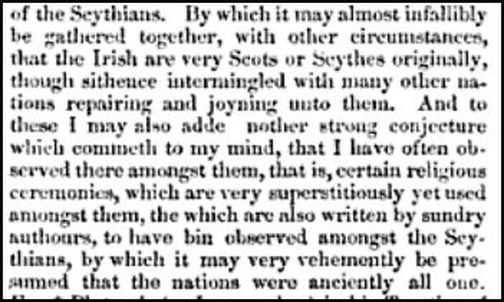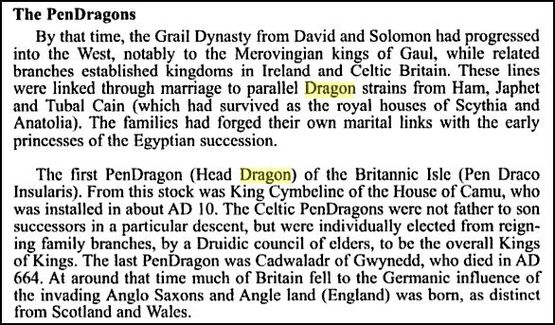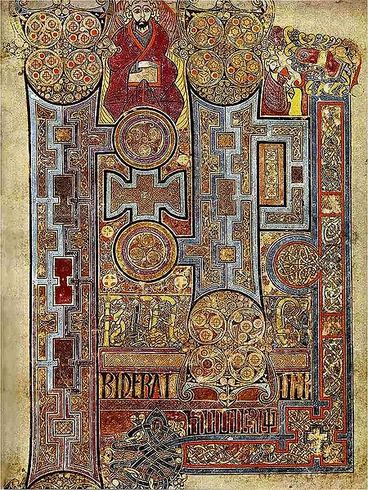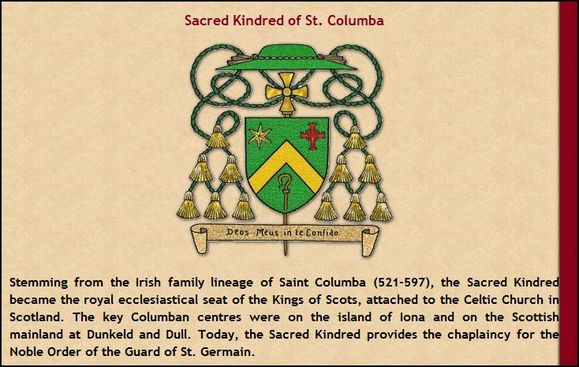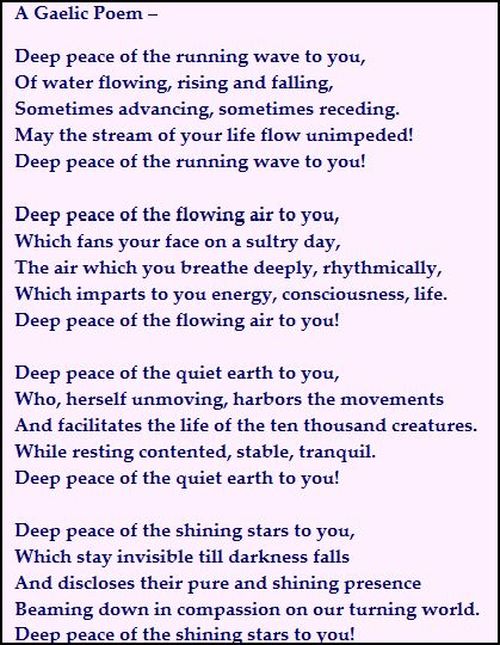Iona Miller 2011 Homepage
by Iona Miller
There is a Celtic saying that heaven and earth are only three feet apart,
but in the thin places that distance is even smaller.
There is a Celtic saying that heaven and earth are only three feet apart,
but in the thin places that distance is even smaller.
IONA, SACRED ISLE
by Iona Miller
In the windswept islands of New Hebrides,
Surrounded by mighty and dangerous seas,
Lies a pristine island of ancient paganism,
And the first monastery of a by-gone schism.
It is ever and now that same place still,
Once known to Celts as ancient Icolmkill.
Home to the last Druids’ spiritual predominance,
They met here in stone circles until the final dance.
Supplanted by the first post-Celtic Christian monasteries,
The Druids gave reluctant way to the “Dei cultores.”
These “worshippers of God” within fair Iona’s holy fane,
Were, in turn, pillaged by Viking and Danish rovers, their bane.
Site of Fingal’s Cave and the grave of mad prince MacBeth,
Burial ground of Norse, Irish, and Scottish monarchs at death.
From the stone circles to circular cairns, it’s spiritual history
Preserved in pristine isolation the spirit of ineffable mystery.
It was the home and source of the illuminated Book of Kells,
Miraculously preserved from marauding Viking vandals.
Its sacred sites were inhabited by man as far back as 4000 B.C.
Its bedrocks were forged deep in the volcanic dawn of prehistory.
The breeze bears a fragrant gift; soil itself is considered holy,
Burial there is an honor kept for those few deemed worthy only.
A far-off past of unsurrendering pagans, saints, and warriors,
An elemental place where rocks and stones sing heather flowers.
In the face of its gale-force winds the soul feels cleansed,
Ready to make the historical pilgrimage again and again.
The mighty reputation of this holy isle does still flourish,
For the simplest reason it continues our spirits to nourish.
Each day is a diamond, reflecting brilliant color elusive,
Yet life here is eternally peaceful, slow, and reclusive.
The air is pure and provocative as a kaleidoscope of light,
Casting over all a breezy supernatural veil so starkly bright.
The aqua sea embraces and hoards all that is deemed precious,
A pervading sense of reverence supersedes all other reference.
Time is uniquely different in Iona’s unspoiled pastoral beauty,
Which allows us to feel the depths of our daily spiritual duty.
Dream a journey back to when that circle of stones led to rapture,
And the pagan spirit of those ancient days perhaps we can recapture.
The fertile Druid spirituality of seaweed, mistletoe, oak and yew,
A deep love of cosmos, nature, and mankind did instill and imbue.
Festivals of bonfires and wickermen began each year with Beltane,
And carried through at harvest time with the fire of peace, Samhain.
Observing Full Moons, their history was sung by many Bards,
Who were endowed with powers and inspiration of earth and stars.
In the Sun’s face, beneath that massive revolving eye of light,
They inspired legends as they thronged on plain and height.
“Whose piety would not grow warmer amid Iona’s old ruins?”
Nature’s voice might seem to say, here she speaks in mellow tunes.
So come to Her here and sit beside her salty seaside,
And the natural purity of that briney breeze imbibe.
Enjoy the sanctuary and serenity of this island idyl,
And the unceasing surging of oceanic rhythms tidal.
Dream of her sanctified past while you tranquilly sleep,
And perhaps many changes of the past silently beweep.
In the long lost mists of the hoary Neolithic past,
The awesome tone of this ancient atmosphere was cast.
Once the native Celts and Druids here became adept,
At survival and flourishing, kept from extinction exempt.
Then came genocidal Christians, a cruel medieval relic,
But posing as the true God’s minions, acting so angelic.
Soon, pillaging by Vikings and Danes induced uneasy panics,
Which couldn’t keep these intruders from seizing another annex.
Then the isle became sole property of the Lord Argyl leige,
Which only contributed more to his already substantial prestige.
Alas, he fell on hard times; fair isle Iona was sold cheap as a theft,
Its forced sale left him lesser, and his soul was moreover bereft.
However, in olden times its first saint, Columba had gazed with awe,
At a prophetic vision of the distant future he himself vainly foresaw:
“When all the world in another deluge is destroyed,
Iona will miraculously float like an ark by God buoyed.”
In this sense its sacred soil is holy, numinous, and talismanic,
The primal source of its naturally arcane mysteries are ante-oceanic.
The mad Dane deeply buried in Iona still patiently lies,
And the tortured spirit of the usurped Druids still cries.
by Iona Miller
In the windswept islands of New Hebrides,
Surrounded by mighty and dangerous seas,
Lies a pristine island of ancient paganism,
And the first monastery of a by-gone schism.
It is ever and now that same place still,
Once known to Celts as ancient Icolmkill.
Home to the last Druids’ spiritual predominance,
They met here in stone circles until the final dance.
Supplanted by the first post-Celtic Christian monasteries,
The Druids gave reluctant way to the “Dei cultores.”
These “worshippers of God” within fair Iona’s holy fane,
Were, in turn, pillaged by Viking and Danish rovers, their bane.
Site of Fingal’s Cave and the grave of mad prince MacBeth,
Burial ground of Norse, Irish, and Scottish monarchs at death.
From the stone circles to circular cairns, it’s spiritual history
Preserved in pristine isolation the spirit of ineffable mystery.
It was the home and source of the illuminated Book of Kells,
Miraculously preserved from marauding Viking vandals.
Its sacred sites were inhabited by man as far back as 4000 B.C.
Its bedrocks were forged deep in the volcanic dawn of prehistory.
The breeze bears a fragrant gift; soil itself is considered holy,
Burial there is an honor kept for those few deemed worthy only.
A far-off past of unsurrendering pagans, saints, and warriors,
An elemental place where rocks and stones sing heather flowers.
In the face of its gale-force winds the soul feels cleansed,
Ready to make the historical pilgrimage again and again.
The mighty reputation of this holy isle does still flourish,
For the simplest reason it continues our spirits to nourish.
Each day is a diamond, reflecting brilliant color elusive,
Yet life here is eternally peaceful, slow, and reclusive.
The air is pure and provocative as a kaleidoscope of light,
Casting over all a breezy supernatural veil so starkly bright.
The aqua sea embraces and hoards all that is deemed precious,
A pervading sense of reverence supersedes all other reference.
Time is uniquely different in Iona’s unspoiled pastoral beauty,
Which allows us to feel the depths of our daily spiritual duty.
Dream a journey back to when that circle of stones led to rapture,
And the pagan spirit of those ancient days perhaps we can recapture.
The fertile Druid spirituality of seaweed, mistletoe, oak and yew,
A deep love of cosmos, nature, and mankind did instill and imbue.
Festivals of bonfires and wickermen began each year with Beltane,
And carried through at harvest time with the fire of peace, Samhain.
Observing Full Moons, their history was sung by many Bards,
Who were endowed with powers and inspiration of earth and stars.
In the Sun’s face, beneath that massive revolving eye of light,
They inspired legends as they thronged on plain and height.
“Whose piety would not grow warmer amid Iona’s old ruins?”
Nature’s voice might seem to say, here she speaks in mellow tunes.
So come to Her here and sit beside her salty seaside,
And the natural purity of that briney breeze imbibe.
Enjoy the sanctuary and serenity of this island idyl,
And the unceasing surging of oceanic rhythms tidal.
Dream of her sanctified past while you tranquilly sleep,
And perhaps many changes of the past silently beweep.
In the long lost mists of the hoary Neolithic past,
The awesome tone of this ancient atmosphere was cast.
Once the native Celts and Druids here became adept,
At survival and flourishing, kept from extinction exempt.
Then came genocidal Christians, a cruel medieval relic,
But posing as the true God’s minions, acting so angelic.
Soon, pillaging by Vikings and Danes induced uneasy panics,
Which couldn’t keep these intruders from seizing another annex.
Then the isle became sole property of the Lord Argyl leige,
Which only contributed more to his already substantial prestige.
Alas, he fell on hard times; fair isle Iona was sold cheap as a theft,
Its forced sale left him lesser, and his soul was moreover bereft.
However, in olden times its first saint, Columba had gazed with awe,
At a prophetic vision of the distant future he himself vainly foresaw:
“When all the world in another deluge is destroyed,
Iona will miraculously float like an ark by God buoyed.”
In this sense its sacred soil is holy, numinous, and talismanic,
The primal source of its naturally arcane mysteries are ante-oceanic.
The mad Dane deeply buried in Iona still patiently lies,
And the tortured spirit of the usurped Druids still cries.
Iona, a small island off the west coast of Scotland, is considered to be one of the most holy places in the world.
“In spiritual geography Iona is the Mecca of the Gael. I have long had a conviction—partly an emotion of the imagination, and partly a belief insensibly deduced through a hundred avenues of knowledge and surmise
—that out of Iona is again to come a Divine Word.” – William Sharp
“In spiritual geography Iona is the Mecca of the Gael. I have long had a conviction—partly an emotion of the imagination, and partly a belief insensibly deduced through a hundred avenues of knowledge and surmise
—that out of Iona is again to come a Divine Word.” – William Sharp
SPIRITUAL MAGNETISM: Iona's 1500 million years old rock strata easily distinguished from that of the younger mainland.
"To tell the story of Iona is to go back to God, and to end in God." --Fiona Macleod
Iona had been known by the old gaelic name Innis nan Druidhneach which translates as the Island of the Druids. Moreover, it appears that Iona was a primary seat of learning for the pre-Christian Celtic Druid Magi. Aylett Sammes, in his work Britannia Antiqua Illustrata (1676), states that Scotland was supposed to be the "Original and Capital Seat" of the Druids, and writing about the Druids, the Scottish researcher Lewis Spence says: "Their chief seat in Scotland was the Island of Iona (The Mysteries of Britain, 1928).
"To tell the story of Iona is to go back to God, and to end in God." --Fiona Macleod
Iona had been known by the old gaelic name Innis nan Druidhneach which translates as the Island of the Druids. Moreover, it appears that Iona was a primary seat of learning for the pre-Christian Celtic Druid Magi. Aylett Sammes, in his work Britannia Antiqua Illustrata (1676), states that Scotland was supposed to be the "Original and Capital Seat" of the Druids, and writing about the Druids, the Scottish researcher Lewis Spence says: "Their chief seat in Scotland was the Island of Iona (The Mysteries of Britain, 1928).
|
|
|
A MYSTIC ISLAND BETWEEN HEAVEN & EARTH
by Iona Orr Miller, (c)2010
EDGE OF THE WORLD: Sacred Isle of Iona
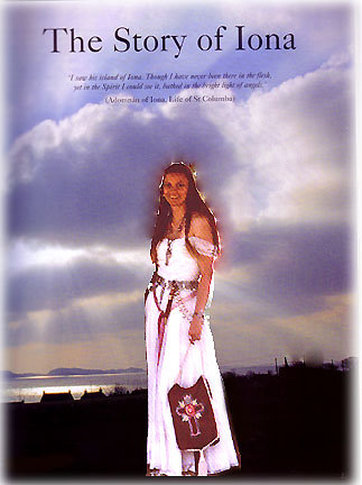
This island set apart, this motherland of many dreams,
still yields its secret, but it is only as men seek that they truly find. To reach the heart of Iona is to find something eternal.... G.E. Troup
Holy Island/Spiritual Sanctuary
I have a rich heritage. I own a treasure -- an ancient and holy name, handed down through my Scottish family for generations. My soul has a mystic home. While no man is an island, I am named after one. Iona is a sanctified Isle in Scotland, which was sacred to the "Celts" and inhabited as the spiritual center of Scotland by Druids, the "servants of truth." It has been the destination of many an epic spiritual journey. The name of this "isle of dreams" has been called "a talisman of spiritual beauty."
Iona was always an island of mystics and scholars. The name, (a corruption of early Gaelic Ii-shona, pronounced, Ee-hona, the 's' in Gaelic being silent before an aspirate), is steeped in multidimensional mystique that can be gradually unfolded in physical, emotional, mental, and spiritual metaphors. But it is more than a metaphor to be unraveled like a Scottish yarn. Indeed, an exciting and illuminating journey to the "heart of Iona" is a soulful initiatory journey into myth and eternity.
Some associate the name back to myths of Zeus and Io, (Heaven and Earth) and ancient Ionia, a coastal region of Turkey, settled by archaic seafaring Greeks after the Trojan War. Ionia was settled in a window of opportunity between the collapse of the Hittite Empire, with the defeat of Troy, and the rise of the last Anatolian power from a neo-Hittite splinter state, Lydia. Ionia was a sacred, rather than political league, distinguished by philosophers, scientists, artists and navigators, among the first to explore the Western Mediterranean.
Myth is a metaphysical system. Earth (Io) is barren until the thunderbolt (Zeus) strikes her in the springtime. Ancients thought the earth was fertilized by Zeus. Thunderbolts as fecundation or impregnator from the heart of heaven is an ancient conception that relates to the popular notion of resonance.
Now we know lightning drives Schumann Resonance to which the whole biosphere is tuned. This tuned system bio-field couples us to the iso-electric field of the planet in the Theta brainwave frequency. These circulating signals have an average value of 7.8 Hz, and the second mode has an average value of 14.1 Hz. It's no accident they match the brain-wave theta rhythm and beta rhythm. A minimum (zero) power circulating in the Earth/ionosphere cavity at 10.4 Hz is virtual match for the average value of the alpha rhythm (8-12 Hz). These are the frequencies of well-being and mystical states. Sacred locations amplify these electromagnetic resonance effects. Our ancestors sensed this intuitively, often building near or with highly conductive stone. Iona is one such psychically conductive locale. Iona is composed exclusively of ancient gneisses and schists of the Lewisian age, including bands of quartzite, serpentine, slate and marble.
Living On the Edge
Alba (Albion in Latin), Indo-European for "white", is the Scottish Gaelic name for Scotland. My Highland family name 'Orr' means someone inhabiting the border, the 'edge' or the shoreline. The topographic origin is from the olde English pre 7th century "ORA" meaning an 'edge', shore or slope. I have lived my life with a foot in each world, the sacred and mundane. The Scottish surname traces back to the Gaelic odhar, meaning "pale", "the pale person", "dun," fair or red haired. The Orr name dates back further than the reign of James VI of Scotland (James I of England). In 1603 when the MacGregors were proscribed, some changed their names to avoid hanging, seeking sanctuary with other clans. Orr was one of the names these "children of the mist" acquired as freedom-fighters.
Padraig Mac Giolla Domhnaigh suggested that the Orr surname originates from an Anglicisation of Gaelic Mac Iomhaire. This was an old name from Renfrewshire, and a sept of the Campbells (Black Watch tartan); he stated that the name was earlier spelt Mac Ure. Historian Edward MacLysaght suggests that the name in Scotland derives from the parish of Orr or Urr in Kirkcudbrightshire, where the River Orr or Urr flowed. John Baliol (mother, Dervorgilla), an estwhile King of Scotland (1292) built his castle there. Land surrounding this river was granted to the Knights Templar by King David I (ruled 1124-1153). Hew Orr or Urr (Hughe de Urre) swore alliegence to King Edward I in 1296. Old variants include Urr, Ure, Oorr, Oare, Owr, Owar, Ower, Oar, Or, Oarr, Oayre, Oure, Our. The Ulster version of the crest of James Orr of the Villa Antoinette, Cannes, France and Belfast has a trefoil. He was the second son of James Orr of Ballygowan and Holywood House, a Belfast banker. His mother was Jane Stewart of the Stewarts of Ballintoy. His grandfather was Alexander Orr. Being a sept or division of the Campbell Clan entitles you to wear the Campbell tartan, also the Jacobite, Caledonia and Black Watch.
Some link Orr to the French d'Or, meaning gold. The Hebrew homonym Aur means 'light,' kabbalistically the highest uplifted state of mind. The speed of light is a function of the universe's mass, determined by its resistance to the infinite in movement emanating from itself. In modern terms, the 'Limitless Light' is the negative existence of virtual photon fluctuation in the so-called vacuum, popularly known as Zero Point Energy from which photons emerge. It is the groundstateof existence. Iona means 'dove' in Hebrew.
My mother is a McKinley, a Scots Gaelic patronymic surname meaning "son of Finlay." The given name Finlay derived from Fionnla or Fionnlaoch meanig "white warrior" or "fair hero." Her middle name, Rae is also a Scottish surname, originally either a short form of MacRae (from a Gaelic personal name meaning ‘son of grace’) or a nickname from the roebuck.
ORR Surname: http://books.google.com/books?id=-Emi0MmvPaEC&pg=PA2&lpg=PA2&dq=Orr+surname+meaning&source=bl&ots=xylcgyyQhi&sig=leY39A3MbcvnPEswcdAQEvwbPOg&hl=en&ei=Z8HZTJHgDoy6sAPQoZS4Bw&sa=X&oi=book_result&ct=result&resnum=8&ved=0CEEQ6AEwBzge#v=onepage&q=Orr%20surname%20meaning&f=false
http://orrnamestudy.com/lochwinnoch.htm
THE LAYS OF IONA http://books.google.com/books?id=pvcqAAAAYAAJ&printsec=frontcover&source=gbs_atb#v=onepage&q&f=false
still yields its secret, but it is only as men seek that they truly find. To reach the heart of Iona is to find something eternal.... G.E. Troup
Holy Island/Spiritual Sanctuary
I have a rich heritage. I own a treasure -- an ancient and holy name, handed down through my Scottish family for generations. My soul has a mystic home. While no man is an island, I am named after one. Iona is a sanctified Isle in Scotland, which was sacred to the "Celts" and inhabited as the spiritual center of Scotland by Druids, the "servants of truth." It has been the destination of many an epic spiritual journey. The name of this "isle of dreams" has been called "a talisman of spiritual beauty."
Iona was always an island of mystics and scholars. The name, (a corruption of early Gaelic Ii-shona, pronounced, Ee-hona, the 's' in Gaelic being silent before an aspirate), is steeped in multidimensional mystique that can be gradually unfolded in physical, emotional, mental, and spiritual metaphors. But it is more than a metaphor to be unraveled like a Scottish yarn. Indeed, an exciting and illuminating journey to the "heart of Iona" is a soulful initiatory journey into myth and eternity.
Some associate the name back to myths of Zeus and Io, (Heaven and Earth) and ancient Ionia, a coastal region of Turkey, settled by archaic seafaring Greeks after the Trojan War. Ionia was settled in a window of opportunity between the collapse of the Hittite Empire, with the defeat of Troy, and the rise of the last Anatolian power from a neo-Hittite splinter state, Lydia. Ionia was a sacred, rather than political league, distinguished by philosophers, scientists, artists and navigators, among the first to explore the Western Mediterranean.
Myth is a metaphysical system. Earth (Io) is barren until the thunderbolt (Zeus) strikes her in the springtime. Ancients thought the earth was fertilized by Zeus. Thunderbolts as fecundation or impregnator from the heart of heaven is an ancient conception that relates to the popular notion of resonance.
Now we know lightning drives Schumann Resonance to which the whole biosphere is tuned. This tuned system bio-field couples us to the iso-electric field of the planet in the Theta brainwave frequency. These circulating signals have an average value of 7.8 Hz, and the second mode has an average value of 14.1 Hz. It's no accident they match the brain-wave theta rhythm and beta rhythm. A minimum (zero) power circulating in the Earth/ionosphere cavity at 10.4 Hz is virtual match for the average value of the alpha rhythm (8-12 Hz). These are the frequencies of well-being and mystical states. Sacred locations amplify these electromagnetic resonance effects. Our ancestors sensed this intuitively, often building near or with highly conductive stone. Iona is one such psychically conductive locale. Iona is composed exclusively of ancient gneisses and schists of the Lewisian age, including bands of quartzite, serpentine, slate and marble.
Living On the Edge
Alba (Albion in Latin), Indo-European for "white", is the Scottish Gaelic name for Scotland. My Highland family name 'Orr' means someone inhabiting the border, the 'edge' or the shoreline. The topographic origin is from the olde English pre 7th century "ORA" meaning an 'edge', shore or slope. I have lived my life with a foot in each world, the sacred and mundane. The Scottish surname traces back to the Gaelic odhar, meaning "pale", "the pale person", "dun," fair or red haired. The Orr name dates back further than the reign of James VI of Scotland (James I of England). In 1603 when the MacGregors were proscribed, some changed their names to avoid hanging, seeking sanctuary with other clans. Orr was one of the names these "children of the mist" acquired as freedom-fighters.
Padraig Mac Giolla Domhnaigh suggested that the Orr surname originates from an Anglicisation of Gaelic Mac Iomhaire. This was an old name from Renfrewshire, and a sept of the Campbells (Black Watch tartan); he stated that the name was earlier spelt Mac Ure. Historian Edward MacLysaght suggests that the name in Scotland derives from the parish of Orr or Urr in Kirkcudbrightshire, where the River Orr or Urr flowed. John Baliol (mother, Dervorgilla), an estwhile King of Scotland (1292) built his castle there. Land surrounding this river was granted to the Knights Templar by King David I (ruled 1124-1153). Hew Orr or Urr (Hughe de Urre) swore alliegence to King Edward I in 1296. Old variants include Urr, Ure, Oorr, Oare, Owr, Owar, Ower, Oar, Or, Oarr, Oayre, Oure, Our. The Ulster version of the crest of James Orr of the Villa Antoinette, Cannes, France and Belfast has a trefoil. He was the second son of James Orr of Ballygowan and Holywood House, a Belfast banker. His mother was Jane Stewart of the Stewarts of Ballintoy. His grandfather was Alexander Orr. Being a sept or division of the Campbell Clan entitles you to wear the Campbell tartan, also the Jacobite, Caledonia and Black Watch.
Some link Orr to the French d'Or, meaning gold. The Hebrew homonym Aur means 'light,' kabbalistically the highest uplifted state of mind. The speed of light is a function of the universe's mass, determined by its resistance to the infinite in movement emanating from itself. In modern terms, the 'Limitless Light' is the negative existence of virtual photon fluctuation in the so-called vacuum, popularly known as Zero Point Energy from which photons emerge. It is the groundstateof existence. Iona means 'dove' in Hebrew.
My mother is a McKinley, a Scots Gaelic patronymic surname meaning "son of Finlay." The given name Finlay derived from Fionnla or Fionnlaoch meanig "white warrior" or "fair hero." Her middle name, Rae is also a Scottish surname, originally either a short form of MacRae (from a Gaelic personal name meaning ‘son of grace’) or a nickname from the roebuck.
ORR Surname: http://books.google.com/books?id=-Emi0MmvPaEC&pg=PA2&lpg=PA2&dq=Orr+surname+meaning&source=bl&ots=xylcgyyQhi&sig=leY39A3MbcvnPEswcdAQEvwbPOg&hl=en&ei=Z8HZTJHgDoy6sAPQoZS4Bw&sa=X&oi=book_result&ct=result&resnum=8&ved=0CEEQ6AEwBzge#v=onepage&q=Orr%20surname%20meaning&f=false
http://orrnamestudy.com/lochwinnoch.htm
THE LAYS OF IONA http://books.google.com/books?id=pvcqAAAAYAAJ&printsec=frontcover&source=gbs_atb#v=onepage&q&f=false
Approximately 60% of all the Campbells tested are likely to be members of Oppenheimer’s R1b-9 sub-clan. This sub-clan is the oldest branch of R1b in the British Isles and the progenitor of other R1b lines including the Celts. This finding is consistent with the finding that most Campbells are members of the indigenous Scottish genotype concluded from my May 2007 analysis. Summer 2008 – The Campbell project has approximately 280 members.
Scota: An Egyptian Spiritual Refugee?

In 1955, archaeologist Dr. Sean O’Riordan of Trinity College, Dublin, made an interesting discovery during an excavation of the Mound of Hostages at Tara, site of ancient kingship of Ireland. Bronze Age skeletal remains were found of what has been argued to be a young prince, still wearing a rare necklace of faience beads, made from a paste of minerals and plant extracts that had been fired.
The skeleton was carbon dated to around 1350 BC. In 1956, J. F. Stone and L. C. Thomas reported that the faience beads were Egyptian: “In fact, when they were compared with Egyptian faience beads, they were found to be not only of identical manufacture but also of matching design.
The famous boy-king Tutankhamun was entombed around the same time as the Tara skeleton and the priceless golden collar around his mummy’s neck was inlaid with matching conical, blue-green faience beads”. An almost identical necklace was found in a Bronze Age burial mound at north Molton, Devon.
Myths of the dragon Princess Scota relate her to the royal Irish and Scottish lines. She is claimed by the Dragon Lineage. According to Bower’s manuscript, Scota’s descendants were the high kings of Ireland. ‘Scota' is not an Egyptian name, but Bower’s manuscript says Scota’s father is actually named Achencres, a Greek version of an Egyptian name. In the work of Manetho, an Egyptian priest, Evans discovers the translation of the name—the pharaoh Achencres was none other than Akhenaten, who reigned in the correct timeframe of 1350 BC.
Evans believes that Scota was Meritaten, eldest daughter of Akhenaten and Nefertiti. The third eldest daughter, Ankhesenpaaten, married her half-brother, King Tutankhamun, son of Akhenaten and his secondary wife, Kiya. The controversial religious shift to the god Aten caused conflict with the Amun priesthood, who reasserted their authority after Akhenaten’s reign ended and he disappeared from history. This conflict and the rumored deaths by plague would have been sufficient motivation for the pharaoh’s eldest daughter to accept a foreign prince in marriage, rather than being Tut’s wife as would have been normal protocol, and to flee from the conflicted country. Her name “Scota” was Scythian for “ruler of the people”.
Scota
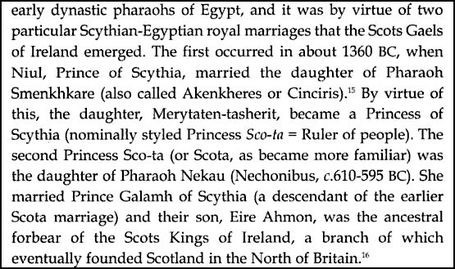
The Story of Princess Scota, By Heather Elizabeth Adams
In 1955, archaeologist Dr. Sean O’Riordan of Trinity College, Dublin, made an interesting discovery during an excavation of the Mound of Hostages at Tara, site of ancient kingship of Ireland. Bronze Age skeletal remains were found of what has been argued to be a young prince, still wearing a rare necklace of faience beads, made from a paste of minerals and plant extracts that had been fired.
The skeleton was carbon dated to around 1350 BC. In 1956, J. F. Stone and L. C. Thomas reported that the faience beads were Egyptian: “In fact, when they were compared with Egyptian faience beads, they were found to be not only of identical manufacture but also of matching design. The famous boy-king Tutankhamun was entombed around the same time as the Tara skeleton and the priceless golden collar around his mummy’s neck was inlaid with matching conical, blue-green faience beads”. An almost identical necklace was found in a Bronze Age burial mound at north Molton, Devon.
In Kingdom of the Ark, Lorraine Evans reveals plausible archaeological connections and evidence between Egypt and Ireland. In 1937 in North Ferriby, Yorkshire, the remains of an ancient boat were discovered. Excavation produced what was thought a Viking longship yet more boats were much older than Viking ships and were of a type found in the Mediterranean. They originated 2000 years before the Viking age and were radiocarbon dated to around 1400 to 1350 BC. Evans argues these boats could originate from Egypt, based on dating of the faience beads. While investigating the origins of the people of Scotland in the Bower manuscript, the Scotichronicon, she discovers the story of Scota, the Egyptian princess and daughter of a pharaoh who fled from Egypt with her husband Gaythelos with a large following of people who arrive in a fleet of ships. They settled in Scotland for a while amongst the natives, until they were forced to leave and landed in Ireland, where they formed the Scotti, and their kings became the high kings of Ireland. In later centuries, they returned to Scotland, defeating the Picts, and giving Scotland its name.
What happens to Scota and her people? Irish myth claims the Tuatha de Danaan, the magical children of the Goddess Danu "originally established the site of Tara, in the Boyne river valley, as the ritual inauguration and burial place of the ancient kings of Ireland. They were generally regarded as the gods and goddesses of the "Celtic" tribes, but it is believed that their true origins date far back into prehistory”. Could the de Danaan even perhaps have been the descendants of the lost land of Atlantis, migrants to Ireland after its final destruction, between 7-10,000 years ago?
Further compounding the mystery, Michael Tsarion offers the revisionist view that Scota was returning to the Western land of Egyptian origins. Was the Irish/Egyptian connection a two-way street? Civilization may have spread into Europe from the West as well as the East. The religion of the Druids parallels the ancient Egyptians. Their name is linked to the word 'door' or portal and 'bringer of truth."
"The Caucasian features described by Sir Elliot Smith are to be seen on the face of Queen Nefertiti, her sister Mutnodjmet (wife of Pharaoh Heremheb), and her daughter Meritaten (Scota). Indeed, there is little doubt in our minds that Nefertiti and her family were of Irish ancestry. This explains why Scota, her eldest daughter, traveled to Ireland by way of Spain after the fall of Akhenaton's corrupt dynasty and why her grave was found, not in Egypt, but in Ireland's County Kerry." ("Irish Origins of Civilzation")
In the Annals of the Four Masters, dating to 1632-36, Scota’s husband is named Eremon, and it is Eremon and Eber who divide the land of Ireland between them, with Eremon in the north and Eber in the south. Egypt was divided into Upper and Lower Egypt, unified by a central connecting city, Memphis. If we consider the existing myths of Ireland’s legends, it, too, was divided to have a central site of unity, known as Mide, the omphalos of Ireland. Within Mide is where the Hill of Tara is situated, as a site of the High Kingship, representing the unity of the land and all of its people.
Sadly, it is in the battle for Ireland at Slieve Mish, as recorded in the Lebor Gabala, that Scota meets a tragic end and is killed. After her death in this battle, the war continued on at Tailtinn against the three kings of the Tuatha de Danaan, the husbands of the Goddesses Banba, Fodla, and Eriu: MacCuill, MacCeacht, and MacGreine. The sons of Mil, after prolonged battle, conquered the de Danaans and took the seat of Tara. According to the Bower manuscript, Scota was buried “between Sliab Mis and the sea,” and her grave, Fert Scota, is found in a glen located in Glenscota. The exact location of Scota’s resting place remains a mystery, much like the particulars of her past. She lent her persona and identity to the landscape of the land she became a part of, giving Scotland her name.
Scotichronicon: http://books.google.com/books?id=B_OfAAAAMAAJ&printsec=frontcover&dq=scotichronicon&source=bl&ots=WKiYYCnSzg&sig=pL5q_lwcdatLti7Fw5YHXOTrgNA&hl=en&ei=xK3dTNuvHZGK4QaY1LwO&sa=X&oi=book_result&ct=result&resnum=3&sqi=2&ved=0CCoQ6AEwAg#v=onepage&q&f=false
TUATHA DA DAANAN http://www.shee-eire.com/magic&mythology/Myths/TheLeborGabala/The-Tuatha-De/Page1.htm
ANNALS OF FOUR MASTERS: http://www.okeefeclan.org/main/images/stories/PDF/Annals_of_Four_Masters.pdf
Lebor Gabala: http://ia341008.us.archive.org/3/items/leborgablare04macauoft/leborgablare04macauoft.pdf
IDENTITY OF THE SCOTTISH NATION: http://books.google.com/books?id=nPpp6ED8c3EC&pg=PA8&lpg=PA8&dq=scythian+scots&source=bl&ots=pDsuCLAZsx&sig=y_rFqtjw0mgwHEeGrsb3I200D3s&hl=en&ei=3FnbTJaCH4z4sAOmvJXlAw&sa=X&oi=book_result&ct=result&resnum=4&ved=0CCkQ6AEwAzgU#v=onepage&q=scythian%20scots&f=false
IRISH ORIGINS OF CIVILIZATION: http://www.irishoriginsofcivilization.com/irishoriginsexcerpts/book1_chap1.html
Druid-Magi Isle / Spiritual Center
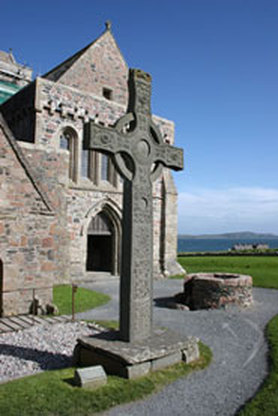
"Metropolis of Dreams"
Iona is a time machine that sends us hurtling back through a vortex of astounding history, romance and imagination. It is the ground zero of Druid tradition and ancient spirituality.
A borderland of legend and history, Iona is a small but highly venerated island composed of some of the most archaic precambrian rock strata on Earth. This original Dreamland rises a meager 400 feet above the sea at its highest. It is a burial place of Kings and related to sea gods, King Arthur and Merlin, the Grail stories, St. Brighid and the Goddess -- Sophia, Virgin of the Light, the archetypal soror mystica. It is also related to Mystery and magic -- Templars, elves, fairies, and pixies; the Sidhe or People of the Hills -- even echoes of vampires, dragons and Annunaki. It's a tale of Sin Eaters, Fairy Ointment, Serpent's Eggs, the Stone of Destiny, Earthworks and Moneymusk Reliquary -- even the "fountain of youth" and sunken Atlantis. Another legend says Mary Magdalene was buried in a cave on the island and in the future a Divine Woman from Iona will redeem the world. Even its Christianity must be seen in a pagan light.
Iona is most anciently known as Ioua, its ancient Gaelic or Pictish name. This is the name invariably used by Adamnán, the ninth abbot, writing at the end of the seventh century. In modern Gaelic it is called “I” (pronounced ee), which simple form means island. In the fifth century the Druids are supposed to have come here to escape the persecution of imperial Rome, and to have founded a library on the island. In 410, when Fergus II became an ally of Alaric the Goth, he added to that library by bringing back books from the plunder of Rome. So it was an established place of learning well before Columba arrived! Another name for the island is Innis nam Druineach, meaning the Island of the Cunning Workmen, or sculptors; and still another is Innis-nam-Druidneach, the Isle of Druids.
The word Iona and the Egyptian On (Heliopolis, holy place, light), are related, as is the kind of theology practiced in both places. The age-old connections between Ireland and Egypt have been guarded for millennia. On was a word used to signify the holiness of light, and was used by the Solar-Cults of Egypt and Ireland. The place-name On is probably realted to the Celtic Iona, the island seat of the Druids in Scotland. Iona is also, said to derive its name from the Gaelic word for 'yew-tree', Ioho or Ioha. When the island was a powerful Druid center it was planted with sacred groves of yew, and the traditions of Iona traditionally involve rebirth and reincarnation. After the arrival of St. Columba, it was also called Icolmkill, "island of Columba of the Church."
On its peak is a holy well called Tobar na h’oige (the Fountain of Youth) on the tiny island of Iona. Behind the ruined walls of the Columban church, the slopes rise, and the one isolated hill of Iona is there, a steep and sudden wilderness. It is commonly called Dûn-I (Doon-ee), for at the summit in old days was an island fortress; but the Gaelic name of the whole of this uplifted shoulder of the isle is Slibh Meanach. Hidden under a wave of heath and boulder, near the broken rocks, is a little pool. From generation to generation this has been known, and frequented, as the Fountain of Youth.
Magical Mystery Tour
A 'Presence' dwells in the hallowed soil of the tiny island which has been washed by the waters of prayer down through the ages. Even a virtual visit to her shores is a journey back through time into the mystic. In her enduring and silent way, Iona continues effecting the spiritual evolution of humanity, whispering her secrets only to a few. Iona is the motherland of dreams. Today around 250,000 people make their way to "the back of the ocean" each year. There is a Gaelic prediction that whoever goes to Iona will go not once, but three times. Iona is a portal to the most ancient history of humankind. We can still imagine and perhaps even smell the raging bonfires that lit Beltane and Samhain festivals of Light. The Irish Druidical rites manifested themselves principally in sun worship. Their chief god was Bel or Baal - the same worshipped by the Phoenicians - the god of the sun.
The Stone of Destiny, (a sizable chunk of red limestone, allegedly Jacob's Pillow), was used at Iona, Dunadd, Dunstaffnage and Scone for enthroning a succession of Dalriadic and subsequent monarchs. The prophet Jeremiah allegedly brought the Scot's Stone of Destiny with him, first to Egypt, then to the British Isles (Jer 43: 6-7). The royal daughter of Jerusalem married the royal house of the British Isles..
St. Columba might have brought the stone from Ireland as a portable altar. Legend calls it Princess Scota's throne. In AD 574, the Stone was used as a coronation chair when Columba anointed and crowned Aedan King of Dalriada. The Stone of Destiny was kept by the monks of Iona, the traditional headquarters of the Scottish Celtic church, until Viking raiding caused them to move to the mainland, first to Dunkeld, Atholl, and then to Scone. Here it continued to be used in coronations, as a symbol of Scottish Kingship.
IONA THE SACRED ISLE: http://books.google.com/books?id=7BMvAAAAMAAJ&pg=PA25&lpg=PA25&dq=iona+%22fountain+of+youth%22&source=bl&ots=gkxuszcRwl&sig=ct__6Wh46yxMIUezcrW5XxxGQ0c&hl=en&ei=m6bkTIamA4mgsQOZm8nwCA&sa=X&oi=book_result&ct=result&resnum=5&ved=0CCkQ6AEwBDge#v=onepage&q&f=false
Urban Iona: Celtic Hospitality in the City: http://books.google.com/books?id=LSx8-CKIO0YC&pg=PA79&lpg=PA79&dq=ley+lines+Iona&source=bl&ots=HNVEWGCUaW&sig=e9dgX4pGqWibLkAJ1a92eqmlV_k&hl=en&ei=VcjxTO6uE5S2sAOE4oWaCw&sa=X&oi=book_result&ct=result&resnum=5&sqi=2&ved=0CDIQ6AEwBA#v=onepage&q=ley%20lines%20Iona&f=false
Were Jesus & Mary Magdalene on the Holy Isle of Iona? http://www.sacredconnections.co.uk/holyland/jesusmarymag_iona.html
Iona is a time machine that sends us hurtling back through a vortex of astounding history, romance and imagination. It is the ground zero of Druid tradition and ancient spirituality.
A borderland of legend and history, Iona is a small but highly venerated island composed of some of the most archaic precambrian rock strata on Earth. This original Dreamland rises a meager 400 feet above the sea at its highest. It is a burial place of Kings and related to sea gods, King Arthur and Merlin, the Grail stories, St. Brighid and the Goddess -- Sophia, Virgin of the Light, the archetypal soror mystica. It is also related to Mystery and magic -- Templars, elves, fairies, and pixies; the Sidhe or People of the Hills -- even echoes of vampires, dragons and Annunaki. It's a tale of Sin Eaters, Fairy Ointment, Serpent's Eggs, the Stone of Destiny, Earthworks and Moneymusk Reliquary -- even the "fountain of youth" and sunken Atlantis. Another legend says Mary Magdalene was buried in a cave on the island and in the future a Divine Woman from Iona will redeem the world. Even its Christianity must be seen in a pagan light.
Iona is most anciently known as Ioua, its ancient Gaelic or Pictish name. This is the name invariably used by Adamnán, the ninth abbot, writing at the end of the seventh century. In modern Gaelic it is called “I” (pronounced ee), which simple form means island. In the fifth century the Druids are supposed to have come here to escape the persecution of imperial Rome, and to have founded a library on the island. In 410, when Fergus II became an ally of Alaric the Goth, he added to that library by bringing back books from the plunder of Rome. So it was an established place of learning well before Columba arrived! Another name for the island is Innis nam Druineach, meaning the Island of the Cunning Workmen, or sculptors; and still another is Innis-nam-Druidneach, the Isle of Druids.
The word Iona and the Egyptian On (Heliopolis, holy place, light), are related, as is the kind of theology practiced in both places. The age-old connections between Ireland and Egypt have been guarded for millennia. On was a word used to signify the holiness of light, and was used by the Solar-Cults of Egypt and Ireland. The place-name On is probably realted to the Celtic Iona, the island seat of the Druids in Scotland. Iona is also, said to derive its name from the Gaelic word for 'yew-tree', Ioho or Ioha. When the island was a powerful Druid center it was planted with sacred groves of yew, and the traditions of Iona traditionally involve rebirth and reincarnation. After the arrival of St. Columba, it was also called Icolmkill, "island of Columba of the Church."
On its peak is a holy well called Tobar na h’oige (the Fountain of Youth) on the tiny island of Iona. Behind the ruined walls of the Columban church, the slopes rise, and the one isolated hill of Iona is there, a steep and sudden wilderness. It is commonly called Dûn-I (Doon-ee), for at the summit in old days was an island fortress; but the Gaelic name of the whole of this uplifted shoulder of the isle is Slibh Meanach. Hidden under a wave of heath and boulder, near the broken rocks, is a little pool. From generation to generation this has been known, and frequented, as the Fountain of Youth.
Magical Mystery Tour
A 'Presence' dwells in the hallowed soil of the tiny island which has been washed by the waters of prayer down through the ages. Even a virtual visit to her shores is a journey back through time into the mystic. In her enduring and silent way, Iona continues effecting the spiritual evolution of humanity, whispering her secrets only to a few. Iona is the motherland of dreams. Today around 250,000 people make their way to "the back of the ocean" each year. There is a Gaelic prediction that whoever goes to Iona will go not once, but three times. Iona is a portal to the most ancient history of humankind. We can still imagine and perhaps even smell the raging bonfires that lit Beltane and Samhain festivals of Light. The Irish Druidical rites manifested themselves principally in sun worship. Their chief god was Bel or Baal - the same worshipped by the Phoenicians - the god of the sun.
The Stone of Destiny, (a sizable chunk of red limestone, allegedly Jacob's Pillow), was used at Iona, Dunadd, Dunstaffnage and Scone for enthroning a succession of Dalriadic and subsequent monarchs. The prophet Jeremiah allegedly brought the Scot's Stone of Destiny with him, first to Egypt, then to the British Isles (Jer 43: 6-7). The royal daughter of Jerusalem married the royal house of the British Isles..
St. Columba might have brought the stone from Ireland as a portable altar. Legend calls it Princess Scota's throne. In AD 574, the Stone was used as a coronation chair when Columba anointed and crowned Aedan King of Dalriada. The Stone of Destiny was kept by the monks of Iona, the traditional headquarters of the Scottish Celtic church, until Viking raiding caused them to move to the mainland, first to Dunkeld, Atholl, and then to Scone. Here it continued to be used in coronations, as a symbol of Scottish Kingship.
IONA THE SACRED ISLE: http://books.google.com/books?id=7BMvAAAAMAAJ&pg=PA25&lpg=PA25&dq=iona+%22fountain+of+youth%22&source=bl&ots=gkxuszcRwl&sig=ct__6Wh46yxMIUezcrW5XxxGQ0c&hl=en&ei=m6bkTIamA4mgsQOZm8nwCA&sa=X&oi=book_result&ct=result&resnum=5&ved=0CCkQ6AEwBDge#v=onepage&q&f=false
Urban Iona: Celtic Hospitality in the City: http://books.google.com/books?id=LSx8-CKIO0YC&pg=PA79&lpg=PA79&dq=ley+lines+Iona&source=bl&ots=HNVEWGCUaW&sig=e9dgX4pGqWibLkAJ1a92eqmlV_k&hl=en&ei=VcjxTO6uE5S2sAOE4oWaCw&sa=X&oi=book_result&ct=result&resnum=5&sqi=2&ved=0CDIQ6AEwBA#v=onepage&q=ley%20lines%20Iona&f=false
Were Jesus & Mary Magdalene on the Holy Isle of Iona? http://www.sacredconnections.co.uk/holyland/jesusmarymag_iona.html
"The Day-Star of the West"
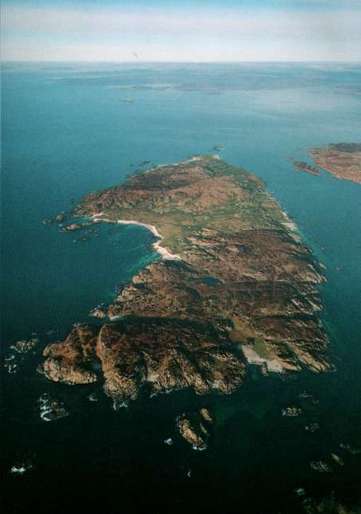
Iona had certainly a Druidical college till the community was expelled by Columba for his own community, and the Highlanders still recognize it as the Druid’s Isle. An old statistical work says, ‘the Druids undoubtedly possessed Iona before the introduction of Christianity.’ It must be admitted that the Culdees wore a white dress, as did the Druids, [and the Essenes] and that they occupied places which had a Druidical reputation. They used the Asiatic cross, now called that of St. Andrew’s. Notably, in an Irish version of the gospel of St. Matthew, the phrase “there came wise men from the east” is rendered “the Druids came from the east.” In like manner, in the Old Testament, Exodus vii. II, the “magicians of Egypt” are made “Druids of Egypt" - James Bonwick (Irish Druids and Old Irish Religions)
Christ is my Druid - St. Columba (from: Six Saints of the Covenant, by Walker)
Pilgrimage of Vital Importance
The island Iona is the shape of a dove and curiously its name even means 'dove' in Hebrew, though it was named after St. Columba. When he was tested by Joseph of Arimathea, the sacred dove came down and perched on Joseph’s rod, signifying the Goddess accepted him to wed Mary. The same dove appeared over the head of Jesus at his baptism as a symbol for wisdom and the Holy Spirit.
In 807, the “Book of Kells” was taken from Iona to Kells to save it from invading Vikings. Now in Trinity College, Dublin and considered to be a national Irish treasure, it is known that the work commenced in Iona… and may even have been finished there.Some speculate a lost treasure of scattered written works remains to be found, cached in parts unknown.
Iona is one of several small islands off the western coast of Scotland, an ancient lava flow, inhabited from megalithic times. Historically, it is known as a ‘sacred isle' because of its pagan and then Christian spiritual activity through the ages. With the arrival of St. Columba on its shores in 563 AD, Iona became a Christian sanctuary. Iona became the center of one of the most important monastic systems in Great Britain and Ireland.
Druid Isle
Iona's Gaelic name, Innis-nam Druidbneach means ‘Island of the Druids'. It had a Druidic college until they were colonized in a conquest without a sword and expelled by St. Columba. Their motto was Y Gwir Erbyn Y Byd (“Truth Against the World”). These Servants of Truth held greater power than the kings who took advice from them: All of nature was sacred to them and they were its students and stewards. The Druid's pre-diluvian theology was based on the observance and veneration of the stars, of the sun, the moon, and the zodiac. It was, from its inception a stellar religion. Druids taught the chldren of the nobility and several kings. Druid means skilled or wisdom. The Merlin was a seer to the King.
These "enlighteners" were fully aware of the 25,9020-year cycle of Precession of the Equinoxes. They were a hereditary caste of seers, philosophers, political advisors, priests, natural scientists, historians, doctors of medicine, judges, poets, royal advisors, astronomers, musicians, geometers, orators, navigators, and magicians. The Bards sang oracular songs. They preserved 'knowledge' or gnosis. The solar deity of Beltane was known as Bel, Beli, Belanus, celebrated with vast bonfires. The Celtic Christian monkish hairstyle, "tonsure" comes from the Druids.
The Druids are men of penetrating and subtle spirit, and acquired the highest renown by their speculations, which were at once subtle and profound. Both Caesar and Mela plainly intimate that they were conversant with most sublime speculations in geometry and in measuring the magnitude of the earth - Ammianus Marscellus (Historian 350 AD)
The Gaelic draeidh (pronounced dhree) means "kindred;" or from druvid that means "one who knows" or "one who has knowledge." The suffix vid (also wid) is the root of wizard and wise. We find this syllable in vedic and veda that connote the highest wisdom. It may also derive from druthin that means "servant of truth." In German it means "of god." An Irish priestess was also known as a druith. We derive the word truth from druthin. The hard "D" sound becomes Anglesized as "T." Another acceptable rendering is from Welsh Gaelic - der wydd, meaning "superior-priest" or "inspector," and from draoith meaning "magician." In Persian we have duree, meaning "noble and holy man," and duracht. In Arabic it is dere, a "wise man," and in Persian it is daru, meaning "Magus." In Punjabi the word dara means "to dare" or to be "fearful," (or "awesome") fearless," "brave," and "bold." We get the word dare from this root. The English dear ("beloved one") derives from the same root. And related also is the Sanskrit Deva (from Duw) meaning “one without darkness.” he word city comes from the Gaelic Cyfaith, meaning "Seat of the Druids". The word can also mean "to shine," and it clearly referred to the sun and to the gods of light such as Indra, Agni, Adonai, and Aton, etc. Undoubtedly, deva is the origin of the word dove. (Tsarion)
Web of the Wise
Tsarion does not regard the term "Celtic" as an accurate description either of the Megalithic Irish or of their European descendants. Recent scientific research strongly supports our contention that the term was merely the concoction of propagandists and mythmongers. As one perceptive commentator said, the Irish were Celticized.
Nicholas de Vere describes ancestral proto-Scythian Druids in The Dragon Cede (2010): "Witch" in Gaelic is "druidhe" -- drui -- or "druid." In practical terms a Scythian druid was an overlord. . .hence, a witch was a Dragon." So, the Druids were Scythian-Draconian overlords who came to proto-Scotland in ancient "Celtic" migrations. The Druids sang the nature of the king and formed all society in so doing. A Pendragon tradition says the Land and the King are one. The king derived his sovereignty, not from the sword, but from Mother Earth. We cannot own land. The land owns us. In original Scythian practice there were Three Kings: Priest King, Peace King, War King. And the Archdruids ruled over all as High Kings. The sword comes from the stone. Sovereignty comes from the Earth beneath our feet. That is the symbolism.
"Street of the Dead"
60 Kings were buried here before the Norman Conquest in 1066. Forty-eight Scottish kings including Mac Beth and the Lords of the Isles were buried in Iona's royal graveyard. The ancient burial ground, called the Rèilig Odhrain (Eng: Oran's "burial place" or "cemetery"), contains the 12th century chapel of St. Odhran (said to be Columba's uncle), restored at the same time as the Abbey itself. It contains a number of medieval grave monuments. The abbey graveyard contains the graves of many early Scottish kings, as well as kings from Ireland, Norway and France. Iona became the burial site for the kings of Dal Riata and their successors. One stone allegedly covers a King of France. Notable burials there include:
Christ is my Druid - St. Columba (from: Six Saints of the Covenant, by Walker)
Pilgrimage of Vital Importance
The island Iona is the shape of a dove and curiously its name even means 'dove' in Hebrew, though it was named after St. Columba. When he was tested by Joseph of Arimathea, the sacred dove came down and perched on Joseph’s rod, signifying the Goddess accepted him to wed Mary. The same dove appeared over the head of Jesus at his baptism as a symbol for wisdom and the Holy Spirit.
In 807, the “Book of Kells” was taken from Iona to Kells to save it from invading Vikings. Now in Trinity College, Dublin and considered to be a national Irish treasure, it is known that the work commenced in Iona… and may even have been finished there.Some speculate a lost treasure of scattered written works remains to be found, cached in parts unknown.
Iona is one of several small islands off the western coast of Scotland, an ancient lava flow, inhabited from megalithic times. Historically, it is known as a ‘sacred isle' because of its pagan and then Christian spiritual activity through the ages. With the arrival of St. Columba on its shores in 563 AD, Iona became a Christian sanctuary. Iona became the center of one of the most important monastic systems in Great Britain and Ireland.
Druid Isle
Iona's Gaelic name, Innis-nam Druidbneach means ‘Island of the Druids'. It had a Druidic college until they were colonized in a conquest without a sword and expelled by St. Columba. Their motto was Y Gwir Erbyn Y Byd (“Truth Against the World”). These Servants of Truth held greater power than the kings who took advice from them: All of nature was sacred to them and they were its students and stewards. The Druid's pre-diluvian theology was based on the observance and veneration of the stars, of the sun, the moon, and the zodiac. It was, from its inception a stellar religion. Druids taught the chldren of the nobility and several kings. Druid means skilled or wisdom. The Merlin was a seer to the King.
These "enlighteners" were fully aware of the 25,9020-year cycle of Precession of the Equinoxes. They were a hereditary caste of seers, philosophers, political advisors, priests, natural scientists, historians, doctors of medicine, judges, poets, royal advisors, astronomers, musicians, geometers, orators, navigators, and magicians. The Bards sang oracular songs. They preserved 'knowledge' or gnosis. The solar deity of Beltane was known as Bel, Beli, Belanus, celebrated with vast bonfires. The Celtic Christian monkish hairstyle, "tonsure" comes from the Druids.
The Druids are men of penetrating and subtle spirit, and acquired the highest renown by their speculations, which were at once subtle and profound. Both Caesar and Mela plainly intimate that they were conversant with most sublime speculations in geometry and in measuring the magnitude of the earth - Ammianus Marscellus (Historian 350 AD)
The Gaelic draeidh (pronounced dhree) means "kindred;" or from druvid that means "one who knows" or "one who has knowledge." The suffix vid (also wid) is the root of wizard and wise. We find this syllable in vedic and veda that connote the highest wisdom. It may also derive from druthin that means "servant of truth." In German it means "of god." An Irish priestess was also known as a druith. We derive the word truth from druthin. The hard "D" sound becomes Anglesized as "T." Another acceptable rendering is from Welsh Gaelic - der wydd, meaning "superior-priest" or "inspector," and from draoith meaning "magician." In Persian we have duree, meaning "noble and holy man," and duracht. In Arabic it is dere, a "wise man," and in Persian it is daru, meaning "Magus." In Punjabi the word dara means "to dare" or to be "fearful," (or "awesome") fearless," "brave," and "bold." We get the word dare from this root. The English dear ("beloved one") derives from the same root. And related also is the Sanskrit Deva (from Duw) meaning “one without darkness.” he word city comes from the Gaelic Cyfaith, meaning "Seat of the Druids". The word can also mean "to shine," and it clearly referred to the sun and to the gods of light such as Indra, Agni, Adonai, and Aton, etc. Undoubtedly, deva is the origin of the word dove. (Tsarion)
Web of the Wise
Tsarion does not regard the term "Celtic" as an accurate description either of the Megalithic Irish or of their European descendants. Recent scientific research strongly supports our contention that the term was merely the concoction of propagandists and mythmongers. As one perceptive commentator said, the Irish were Celticized.
Nicholas de Vere describes ancestral proto-Scythian Druids in The Dragon Cede (2010): "Witch" in Gaelic is "druidhe" -- drui -- or "druid." In practical terms a Scythian druid was an overlord. . .hence, a witch was a Dragon." So, the Druids were Scythian-Draconian overlords who came to proto-Scotland in ancient "Celtic" migrations. The Druids sang the nature of the king and formed all society in so doing. A Pendragon tradition says the Land and the King are one. The king derived his sovereignty, not from the sword, but from Mother Earth. We cannot own land. The land owns us. In original Scythian practice there were Three Kings: Priest King, Peace King, War King. And the Archdruids ruled over all as High Kings. The sword comes from the stone. Sovereignty comes from the Earth beneath our feet. That is the symbolism.
"Street of the Dead"
60 Kings were buried here before the Norman Conquest in 1066. Forty-eight Scottish kings including Mac Beth and the Lords of the Isles were buried in Iona's royal graveyard. The ancient burial ground, called the Rèilig Odhrain (Eng: Oran's "burial place" or "cemetery"), contains the 12th century chapel of St. Odhran (said to be Columba's uncle), restored at the same time as the Abbey itself. It contains a number of medieval grave monuments. The abbey graveyard contains the graves of many early Scottish kings, as well as kings from Ireland, Norway and France. Iona became the burial site for the kings of Dal Riata and their successors. One stone allegedly covers a King of France. Notable burials there include:
- Cináed mac Ailpín, king of the Picts (also known today as "Kenneth I of Scotland")
- Domnall mac Causantín, alternatively "king of the Picts" or "king of Alba" (i.e. Scotland; known as "Donald II")
- Máel Coluim mac Domnaill, king of Scotland ("Malcolm I")
- Donnchad mac Crínáin, king of Scotland ("Duncan I")
- Mac Bethad mac Findlaích, king of Scotland ("Macbeth")
- Domnall mac Donnchada, king of Scotland ("Domnall Bán" or "Donald III")
Atlantis, Serpent's Egg & Ankh
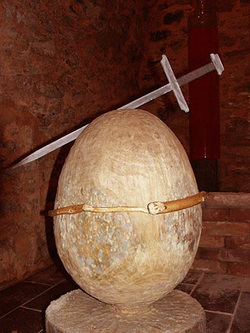
…The outer darkness is a great serpent, the tail of which is in is mouth, and it is outside the whole world, and surroundeth the whole world: in it there are many places of punishment, and it containeth twelve halls wherein severe punishment is inflicted. In each hall is a governor differing from that of his neighbor - Egyptian Passage (from E. A. Wallis Budge's The Gods of the Egyptians, Vol. 1)
"The serpent is the symbol and prototype of the Universal Savior, who redeems the worlds by giving creation the knowledge of itself and the realization of good and evil." [Manly P. Hall, 33 Degree Mason, The Secret Teachings of All Ages , the Philosophical Research Society Press, p. lxxxviii.]
Witch Way?
Evidence suggests early migrations from the West to the East, and that it was these which transmitted the elements of civilization to the world at large, before the return waves of Celtic-Scythian "Druids". Many religiious symbols were first employed by the Druid elders of the West, once known throughout the world as the Arya. The name of Ireland was originally Ari or Arya Land. One of the main connotations of this term was "Western Land." Another connotation was "Land of the Pure or Noble Ones." The high priests of Ireland - the original prehistoric inhabitants, Arya or Aryans - are commonly known as "Druids."
Hard as it is for most of us to comprehend, once-upon-a-time the little green island of Ireland was home to the world's original aristocracy. This fact has not been conceded by the vast majority of Celtic scholars who are for the most part in doubt about where the so-called "Celts" originally came from, and unaware that the term "Celt," as promulgated by Roman mythmongers, is both inaccurate and prejudicial. The many prehistoric and historic migrations to the British Isles (of Iberians, Celts, Gaels, and so on) were for the most part returns. During the so-called "Age of Catastrophe," titanic cataclysms (following on from those that destroyed Atlantis) displaced the original inhabitants of Britain, who were forced to flee to the Continent across land-bridges now lost beneath the waves.
During and after the Age of Catastrophe their ancestors (the pure Arya) fled from Britain to Northern and Eastern Europe, and from there further Eastward toward Syria, Palestine, and India. Although the Scythians of later ages were originally affiliated with the Megalithic Arya, some of their number became spiritually and morally corrupt. Today, a few mainstream historians and archeologists hesitatingly accept that Western "Celts" (as they are erroneously called) had settlements in the Middle and Far East. This is because these migrations were relatively late, historically speaking. They date from approximately 600 years BC onward. he Hyksos/Atonists were originally Scythians from the West. Tsarion asserts that Akhenaton's first wife Nefertiti, her daughter Meritaten, and their descendents, were Scythians. After the fall of Akhenaton, their descendents eventually migrated to their ancestral homes in the West in order to establish a new empire. From Britain they exercised control over their many lieutenants in Athens, Rome, Tanis, Alexandria, Judea, and elsewhere. (Tsarion)
The Ouroboros can be traced back to ancient Egypt, circa 1600 BCE. Also the serpent entwined around the (serpent's) egg, was a symbol common to the Egyptians and the Druids. It referred to the creation of the Universe, Precession and the Milky Way. The World egg also known as the Serpent’s Egg, or the Druid’s Egg is a potent symbol of the union of masculine and feminine. It depicts the creation of the World from these two aspects of divinity and reminds us that we contain both male and female within us.
The remains of over 350 megalithic standing stones are found on Iona. One site is still called the Tabernacle of Culdees. Culdees means “certain strangers,” a term applied to the Druids, which changed over the centuries to Coli Dei, “servants of the Lord,” used for the Christian monks that worshiped on the island beginning in the 6th century.
Some say Iona was an Atlantean colony before it became separated from the mainland. Survivors of drowned islands, they knew the nature of cataclysm. Arguably, according to de Vere's research, the Atlanteans were antediluvian Dragon gods of ancient proto-Scythia driven from their homeland by the Black Sea flood, now scientifically dated to 6,900 years ago when vast ice sheets melted inundating their freshwater lake with seawater. This led to mass migrations as the climate re-adjusted.
Legend says, "One group consisting of seven males, three females and one child, established the Atlantean colony on Iona. They built a small library for ancient sacred works. Around the library which they called their ‘heart seed', they built a strong, almost fortress like Temple." They called Iona Aberuk, or "distant place of the heart'." It is said the Hyperboreans called it Luma or "bright land." The priestesses on Iona called themselves the Priestesses of Ank, or ‘sacred well of life'. Ank is strongly suggestive of the Egyptian Ankh, symbol of life. Ionian priestesses were the basis for the Celtic legends concerning sanctuaries of ‘Lady of the Lake' type anima women who regenerate the male psyche and often his physical form as well.
Descriptions of activities on Iona throughout history echo Egyptian forebearers. The Egyptians had several classes of priesthood, but the Sesh-Per-Ankh were the scribes of the House of Life. These, too, were frequently associated with magical knowledge because of their connection with the sacred texts. The scribes worked largely within the Per-Ankh copying temple texts. They were considered to be very wise and scholarly. The scribes were also considered to be healers, possessing medical knowledge (Sauneron 1960.63). These were likely to have been part of the permanent staff of priesthood as opposed to the rotating sAw/Phylae priesthood (Pinch 1994.53). Dr. Serge Sauneron describes the activities of the scribes in the Per-Ankh very well:
"The main activities in the house of life consisted in preparing the religious works necessary to the cult, in recopying the old manuscripts, in correcting errors, in completing the gaps and passages short of lines; they developed the texts of theology or of liturgy particular to each temple; they prepared the magic books of protection, the astronomical tables; they recopied a thousand times, versions of the Book of the Dead; they discussed with ardor, between copying sessions, philosophical and religious problems, without neglecting medicine and literary activities . . . For everything was not just mechanical copying, in these studies; sometimes an original text, sometimes a theosophical exposition would be drawn up following meditation or the exchange of fruitful views . . . Some of the finest spiritual or ethical texts we possess were stimulated by the reflections and convictions of some obscure scribe whose name will never be known to us . . ." (Sauneron 1960.136)
Key of Eternal Life
Some argue that Ankh represents the sexual unity of male and female, which is considered the basis for eternal life. The lower vertical line of the Ankh is said to represent the penis of the male, and the upper oval of the Ankh is said to represent the vagina or womb of the woman. Nicholas de Vere claims, "The Cult of the Ankh or Ankou was the Court of the Dragon of Ankh-fn-Khonsu and his successor Sobekhnefru, whose most sacred inner symbol, historically, was the winged Orobouros with a pendant Greek cross; the Ankh of Nin-Kursag or Hathor, and her daughter Innana or Venus. In tracing the history of one, via Egypt to its ancient Sumerian roots, we inevitably therefore recount the story of the other."
"Related to the word Ankh are; Anjou, Angouleme, Anschau, Ankou. The cult of the Ankou or Ankh: Consonant migration - This can take place with the change in phonetic accentuation, regional pronunciation, changes in fashion, the vocalization of the words by non-native speakers and the copying of manuscripts by foreign scholars or the scribes of subsequent generation.
SaAnkhTuary
In this case it appears that the original word Ankh has developed into Anjou via a linguistic path influenced by Goidelic. Spelt ’Ankh’ the H in Gaelic would have become aspirant which would have been pronounced Ank-Huh or Ankuh. Verbally the K became mistaken for a hard G, giving Anguh. In due course the G became non-Goidelic and soft, as in ’germ’ and, with the emergence of the letter J as a softer variant of the soft G, the Word Ankh, via Ankhu, Ankou and Angou (as in Angouleme) became Anjou.
The cult of the Ankou in Brittany and Anjou, the cult of the Spirit of the An, derivatively therefore the cult of the Dragon’s Breath, prior to its introduction to the continent, is asserted to have been of immediate British origin, although it was strongly represented in the Island now known as Ireland in pre-christian times, where it was probably originally introduced first by the Egyptian Princess Scota, the wife of the governor (or king) of the Red Sea nome, Niall of Scythia (see charts).
It is said that it was introduced into Brittany during one of the migrations from Albany in the first millennium AD. Described as a cult of the dead, the rites and symbols associated with the characters who were claimed or appear to be its royal priests and priestesses reveal that it was also a cult of blood and death, as well as ancestor veneration. In lowland Scotland the spoken tongue was Northern Cymric and in this language ’angev’, it is said, is one of the words used to describe death, possibly suggesting ’going to the Dragon’, the Church’s ’Devil’. It is significant linguistically because the later house of Plantagenet were called the Angevin Kings."
"The Cult of Ankou", Nicholas de Vere: http://www.bibliotecapleyades.net/dragons/esp_sociopol_dragoncourt02_08.htm
Whose Druids? Which Druids?
Why would one find serpent's eggs venerated in a land with no snakes? In light of this, when we read in Irish legends of the arrival of Saint Patrick, and of his casting out "serpents" from the land, we understand that the reference was not to physical snakes but to the non-Christian Druidic "Serpent Priesthood" he was apparently sent to depose and eradicate. We get one story from the perspective of indigeneous megalithic descendants and another from the returning Scythian dragon line. The later annihilated the former, according to Michael Tsarion. To the former Culdee mean refugee or homeless invader.
Abaris, the great Druid, traveled Eastward to the school of master Pythagoras ("I am the serpent") to bring what would later be referred to as "Kabalistic" instruction to the Hellenes, while other acolytes and priests from Ireland set up sacred colleges throughout the world. The Druidism of post-Christian times, as well as the Druidism presented to us in official accounts, is not the same thing as actual Druidism. It is mere propaganda and distortion.
The original unadulterated solar church existed in Ireland from before the time of the historically known "Druids." The Megalithic Irish (or Arish) were known as the Hyperboreans, which implied not only that they inhabited Northern climes but that they were the descendants of the pre-diluvian inhabitants of Atlantis, Lemuria, and the other lost civilizations that flourished in the world before the cataclysms that particularly devastated the lands of the North-West.
Opposite to the coast of Gallia Celtica there is an island in the ocean, no smaller than Sicily - lying to the north, which is inhabited by the Hyperboreans, who are so named because they dwell beyond the north wind. This island is of a happy temperature, rich in soil, and fruitful in every thing, yielding its produce twice in the year. Tradition says that Latona was born there, and for that reason they venerate Apollo more than any other god. They are in a manner his priests, for they daily celebrate him with continual songs of praise, and pay him abundant honors - Diodorus Siculus (Greek Historian, 90-30 BC)
The prolonged and various effects of this prehistoric upheaval were chronicled by the literati of later civilized nations and cultures. It is clear, however, that even before the upheavals proto-Druidic teachings and technical expertise had been dispersed throughout the world to enrich civilizations not only of Eastern lands but also of the Americas. These academies were the prototypes for those of later ages, at Iona, Nineveh, Tyre, Carthage, Alexandria, Pergamon, Athens, Sparta, Ephyra, Benares, Thebes, and elsewhere. These colleges were presided over by the Servants of Truth - those Elders who have since become known as the "Druids." (Tsarion)
…there is also an international dimension…to druidic activity…if we think of Caesar's statement…that the Gauls believed that Druidism was discovered in Britain, and that those wishing to perfect their knowledge of the discipline travel there in order to do so, we must accept the fact of its boundary-less quality. And, considering the even larger context extending beyond the Celtic world, and what we have seen as broad similarities shared by that world with Roman, Teutonic, Lithuanian, Thracian, Persian, and Indian, we must entertain as quite reasonable Chadwick's suggestion that the Druids along with the others form a common mantic chain - Paul R. Lonigan (The Druids: Priests of the Ancient Celts, 1996)
Wise As Serpents
The Druids held the symbols of the serpent and the dragon in the highest esteem and considered them insignias of royalty. They referred to themselves as Naddreds. This word means "Wise Serpent." It may be connected to the Hebrew Naassians (a title meaning "Serpent Priests" from nasi meaning "saintly leader"), and to Nagas (a Hindu word meaning "Kingly Serpents"). We derive the word adder from it.
According to Irish mythology, the Druid Arphaxad referred to himself thusly: I am a Druid, I am an Architect, I am a Prophet, I am a Serpent Scholar and occultist
Manly Palmer Hall wrote of the ancient priesthood who were known as the Serpent Kings. In his masterpiece The Secret Teachings of All Ages, he wrote: The priests of the Mysteries were symbolized as a serpent, sometimes called Hydra...The Serpent Kings reigned over the earth. It was these Serpent Kings who founded the Mystery Schools which later appeared as the Egyptian and Brahmin Mysteries...The serpent was their symbol...They were the true Sons of Light, and from them have descended a long line of adepts and initiates The symbol of the serpent is found throughout Ireland where physical snakes never existed. This is because there is a world of difference between physical snakes and the symbols of dragons or serpents.
"Wise Serpent" refers to those who were initiated into the highest mysteries. It signified those who possessed healing abilities and great knowledge of astronomy and astrology. The Magi of Ireland were expert architects and they had the most intimate connection to flora and fauna. Like the pharaohs of Egypt they were semi-enlightened beings who lived in harmony with each other and with nature. They obeyed nature's superordinate laws and knew well the penalties for breaching them. The druids were the exclusive intellectual elite, and were recruited among the ranks of the nobility. They enjoyed special privileges, such as exemption from tributes and were not obliged to bear arms coins…Their education was very lengthy, and involved twenty years of memorizing sacred texts which religious taboo banned from being put in writing…In their religious role, the druids insured the conduct of religious practices, presided over sacrificial rites, and received and interpreted omens. The only ones "to know the nature of the gods," they acted as intermediaries between the world of humankind and the domain of the supernatural. Guardians of the fundamental gnosis, they perpetuated a conception of mankind and the universe contained in an esoteric doctrine which, for obvious reasons, remains a mystery - Otto Herman Frey (The Celts)
No Celt has left us a record of his faith and practice, and the unwritten poems of the Druids died with them. Yet from these fragments we see the Celt as the seeker after God, linking himself by strong ties to the unseen, and eager to conquer the unknown by religious rite or magic art. For the things of the spirit have never appealed in vain to the Celtic soul, and long ago classical observers were struck with the religiosity of the Celts - J. A. MacCulloch (The Religion of the Ancient Celts, 1911)
The Druids taught the doctrine of the one supreme being, a future state of rewards and punishments, the immortality of the soul and a metempsychosis...Their doctrines were chiefly those of the Pythagoreans. Their authority in many cases exceeded that of the monarch. They were, of course, the sole interpreters of religion, and consequently superintended all sacrifices; for no private person was allowed to offer a sacrifice without their sanction. They possessed the power of excommunication, which was the most horrible punishment that could be inflicted next to that of death...As the Romans gained ground in these islands the power of the Druids gradually declined; and they were finally assailed by Suetonius Paulinis, governor of Britain under Nero, AD 61 - Charles William Heckethorn (Secret Societies of All Ages and Countries)
The serpentine shapes we see on later monkish books, such as the famous Book of Kells, have a much earlier origin than we have been told. Their significance has to do with arcane mysteries and the bloodline of the kings. The Welsh term for the Gaelic kings was Pendragon. This title meant "Head of the Dragons" and it referred to a kingly bloodline going back to the ante-diluvian epoch. No country in Europe is so associated with the Serpent as Ireland, and none has so many myths and legends connected with the same. As that creature has furnished so many religious stories in the East, and as the ancient faiths of Asia and Egypt abound in references to it, we may reasonably look for some remote similarity in the ideas of worship between Orientals and the sons of Erin - James Bonwick (Irish Druids and Old Irish Religions) (Tsarion)
Gaelic Scythians (Sarmatians, Ossetians, Massagetae) of Europe, were closely allied with the Egyptian pharaohs of the Delta region, those same Hyksos Kings. The old Irish annals refer to the descendants of the Scythians who had lived in Egypt, as "Milesians." This was a name taken from their great chieftain Mile (Scottish Gathelos).
"The serpent is the symbol and prototype of the Universal Savior, who redeems the worlds by giving creation the knowledge of itself and the realization of good and evil." [Manly P. Hall, 33 Degree Mason, The Secret Teachings of All Ages , the Philosophical Research Society Press, p. lxxxviii.]
Witch Way?
Evidence suggests early migrations from the West to the East, and that it was these which transmitted the elements of civilization to the world at large, before the return waves of Celtic-Scythian "Druids". Many religiious symbols were first employed by the Druid elders of the West, once known throughout the world as the Arya. The name of Ireland was originally Ari or Arya Land. One of the main connotations of this term was "Western Land." Another connotation was "Land of the Pure or Noble Ones." The high priests of Ireland - the original prehistoric inhabitants, Arya or Aryans - are commonly known as "Druids."
Hard as it is for most of us to comprehend, once-upon-a-time the little green island of Ireland was home to the world's original aristocracy. This fact has not been conceded by the vast majority of Celtic scholars who are for the most part in doubt about where the so-called "Celts" originally came from, and unaware that the term "Celt," as promulgated by Roman mythmongers, is both inaccurate and prejudicial. The many prehistoric and historic migrations to the British Isles (of Iberians, Celts, Gaels, and so on) were for the most part returns. During the so-called "Age of Catastrophe," titanic cataclysms (following on from those that destroyed Atlantis) displaced the original inhabitants of Britain, who were forced to flee to the Continent across land-bridges now lost beneath the waves.
During and after the Age of Catastrophe their ancestors (the pure Arya) fled from Britain to Northern and Eastern Europe, and from there further Eastward toward Syria, Palestine, and India. Although the Scythians of later ages were originally affiliated with the Megalithic Arya, some of their number became spiritually and morally corrupt. Today, a few mainstream historians and archeologists hesitatingly accept that Western "Celts" (as they are erroneously called) had settlements in the Middle and Far East. This is because these migrations were relatively late, historically speaking. They date from approximately 600 years BC onward. he Hyksos/Atonists were originally Scythians from the West. Tsarion asserts that Akhenaton's first wife Nefertiti, her daughter Meritaten, and their descendents, were Scythians. After the fall of Akhenaton, their descendents eventually migrated to their ancestral homes in the West in order to establish a new empire. From Britain they exercised control over their many lieutenants in Athens, Rome, Tanis, Alexandria, Judea, and elsewhere. (Tsarion)
The Ouroboros can be traced back to ancient Egypt, circa 1600 BCE. Also the serpent entwined around the (serpent's) egg, was a symbol common to the Egyptians and the Druids. It referred to the creation of the Universe, Precession and the Milky Way. The World egg also known as the Serpent’s Egg, or the Druid’s Egg is a potent symbol of the union of masculine and feminine. It depicts the creation of the World from these two aspects of divinity and reminds us that we contain both male and female within us.
The remains of over 350 megalithic standing stones are found on Iona. One site is still called the Tabernacle of Culdees. Culdees means “certain strangers,” a term applied to the Druids, which changed over the centuries to Coli Dei, “servants of the Lord,” used for the Christian monks that worshiped on the island beginning in the 6th century.
Some say Iona was an Atlantean colony before it became separated from the mainland. Survivors of drowned islands, they knew the nature of cataclysm. Arguably, according to de Vere's research, the Atlanteans were antediluvian Dragon gods of ancient proto-Scythia driven from their homeland by the Black Sea flood, now scientifically dated to 6,900 years ago when vast ice sheets melted inundating their freshwater lake with seawater. This led to mass migrations as the climate re-adjusted.
Legend says, "One group consisting of seven males, three females and one child, established the Atlantean colony on Iona. They built a small library for ancient sacred works. Around the library which they called their ‘heart seed', they built a strong, almost fortress like Temple." They called Iona Aberuk, or "distant place of the heart'." It is said the Hyperboreans called it Luma or "bright land." The priestesses on Iona called themselves the Priestesses of Ank, or ‘sacred well of life'. Ank is strongly suggestive of the Egyptian Ankh, symbol of life. Ionian priestesses were the basis for the Celtic legends concerning sanctuaries of ‘Lady of the Lake' type anima women who regenerate the male psyche and often his physical form as well.
Descriptions of activities on Iona throughout history echo Egyptian forebearers. The Egyptians had several classes of priesthood, but the Sesh-Per-Ankh were the scribes of the House of Life. These, too, were frequently associated with magical knowledge because of their connection with the sacred texts. The scribes worked largely within the Per-Ankh copying temple texts. They were considered to be very wise and scholarly. The scribes were also considered to be healers, possessing medical knowledge (Sauneron 1960.63). These were likely to have been part of the permanent staff of priesthood as opposed to the rotating sAw/Phylae priesthood (Pinch 1994.53). Dr. Serge Sauneron describes the activities of the scribes in the Per-Ankh very well:
"The main activities in the house of life consisted in preparing the religious works necessary to the cult, in recopying the old manuscripts, in correcting errors, in completing the gaps and passages short of lines; they developed the texts of theology or of liturgy particular to each temple; they prepared the magic books of protection, the astronomical tables; they recopied a thousand times, versions of the Book of the Dead; they discussed with ardor, between copying sessions, philosophical and religious problems, without neglecting medicine and literary activities . . . For everything was not just mechanical copying, in these studies; sometimes an original text, sometimes a theosophical exposition would be drawn up following meditation or the exchange of fruitful views . . . Some of the finest spiritual or ethical texts we possess were stimulated by the reflections and convictions of some obscure scribe whose name will never be known to us . . ." (Sauneron 1960.136)
Key of Eternal Life
Some argue that Ankh represents the sexual unity of male and female, which is considered the basis for eternal life. The lower vertical line of the Ankh is said to represent the penis of the male, and the upper oval of the Ankh is said to represent the vagina or womb of the woman. Nicholas de Vere claims, "The Cult of the Ankh or Ankou was the Court of the Dragon of Ankh-fn-Khonsu and his successor Sobekhnefru, whose most sacred inner symbol, historically, was the winged Orobouros with a pendant Greek cross; the Ankh of Nin-Kursag or Hathor, and her daughter Innana or Venus. In tracing the history of one, via Egypt to its ancient Sumerian roots, we inevitably therefore recount the story of the other."
"Related to the word Ankh are; Anjou, Angouleme, Anschau, Ankou. The cult of the Ankou or Ankh: Consonant migration - This can take place with the change in phonetic accentuation, regional pronunciation, changes in fashion, the vocalization of the words by non-native speakers and the copying of manuscripts by foreign scholars or the scribes of subsequent generation.
SaAnkhTuary
In this case it appears that the original word Ankh has developed into Anjou via a linguistic path influenced by Goidelic. Spelt ’Ankh’ the H in Gaelic would have become aspirant which would have been pronounced Ank-Huh or Ankuh. Verbally the K became mistaken for a hard G, giving Anguh. In due course the G became non-Goidelic and soft, as in ’germ’ and, with the emergence of the letter J as a softer variant of the soft G, the Word Ankh, via Ankhu, Ankou and Angou (as in Angouleme) became Anjou.
The cult of the Ankou in Brittany and Anjou, the cult of the Spirit of the An, derivatively therefore the cult of the Dragon’s Breath, prior to its introduction to the continent, is asserted to have been of immediate British origin, although it was strongly represented in the Island now known as Ireland in pre-christian times, where it was probably originally introduced first by the Egyptian Princess Scota, the wife of the governor (or king) of the Red Sea nome, Niall of Scythia (see charts).
It is said that it was introduced into Brittany during one of the migrations from Albany in the first millennium AD. Described as a cult of the dead, the rites and symbols associated with the characters who were claimed or appear to be its royal priests and priestesses reveal that it was also a cult of blood and death, as well as ancestor veneration. In lowland Scotland the spoken tongue was Northern Cymric and in this language ’angev’, it is said, is one of the words used to describe death, possibly suggesting ’going to the Dragon’, the Church’s ’Devil’. It is significant linguistically because the later house of Plantagenet were called the Angevin Kings."
"The Cult of Ankou", Nicholas de Vere: http://www.bibliotecapleyades.net/dragons/esp_sociopol_dragoncourt02_08.htm
Whose Druids? Which Druids?
Why would one find serpent's eggs venerated in a land with no snakes? In light of this, when we read in Irish legends of the arrival of Saint Patrick, and of his casting out "serpents" from the land, we understand that the reference was not to physical snakes but to the non-Christian Druidic "Serpent Priesthood" he was apparently sent to depose and eradicate. We get one story from the perspective of indigeneous megalithic descendants and another from the returning Scythian dragon line. The later annihilated the former, according to Michael Tsarion. To the former Culdee mean refugee or homeless invader.
Abaris, the great Druid, traveled Eastward to the school of master Pythagoras ("I am the serpent") to bring what would later be referred to as "Kabalistic" instruction to the Hellenes, while other acolytes and priests from Ireland set up sacred colleges throughout the world. The Druidism of post-Christian times, as well as the Druidism presented to us in official accounts, is not the same thing as actual Druidism. It is mere propaganda and distortion.
The original unadulterated solar church existed in Ireland from before the time of the historically known "Druids." The Megalithic Irish (or Arish) were known as the Hyperboreans, which implied not only that they inhabited Northern climes but that they were the descendants of the pre-diluvian inhabitants of Atlantis, Lemuria, and the other lost civilizations that flourished in the world before the cataclysms that particularly devastated the lands of the North-West.
Opposite to the coast of Gallia Celtica there is an island in the ocean, no smaller than Sicily - lying to the north, which is inhabited by the Hyperboreans, who are so named because they dwell beyond the north wind. This island is of a happy temperature, rich in soil, and fruitful in every thing, yielding its produce twice in the year. Tradition says that Latona was born there, and for that reason they venerate Apollo more than any other god. They are in a manner his priests, for they daily celebrate him with continual songs of praise, and pay him abundant honors - Diodorus Siculus (Greek Historian, 90-30 BC)
The prolonged and various effects of this prehistoric upheaval were chronicled by the literati of later civilized nations and cultures. It is clear, however, that even before the upheavals proto-Druidic teachings and technical expertise had been dispersed throughout the world to enrich civilizations not only of Eastern lands but also of the Americas. These academies were the prototypes for those of later ages, at Iona, Nineveh, Tyre, Carthage, Alexandria, Pergamon, Athens, Sparta, Ephyra, Benares, Thebes, and elsewhere. These colleges were presided over by the Servants of Truth - those Elders who have since become known as the "Druids." (Tsarion)
…there is also an international dimension…to druidic activity…if we think of Caesar's statement…that the Gauls believed that Druidism was discovered in Britain, and that those wishing to perfect their knowledge of the discipline travel there in order to do so, we must accept the fact of its boundary-less quality. And, considering the even larger context extending beyond the Celtic world, and what we have seen as broad similarities shared by that world with Roman, Teutonic, Lithuanian, Thracian, Persian, and Indian, we must entertain as quite reasonable Chadwick's suggestion that the Druids along with the others form a common mantic chain - Paul R. Lonigan (The Druids: Priests of the Ancient Celts, 1996)
Wise As Serpents
The Druids held the symbols of the serpent and the dragon in the highest esteem and considered them insignias of royalty. They referred to themselves as Naddreds. This word means "Wise Serpent." It may be connected to the Hebrew Naassians (a title meaning "Serpent Priests" from nasi meaning "saintly leader"), and to Nagas (a Hindu word meaning "Kingly Serpents"). We derive the word adder from it.
According to Irish mythology, the Druid Arphaxad referred to himself thusly: I am a Druid, I am an Architect, I am a Prophet, I am a Serpent Scholar and occultist
Manly Palmer Hall wrote of the ancient priesthood who were known as the Serpent Kings. In his masterpiece The Secret Teachings of All Ages, he wrote: The priests of the Mysteries were symbolized as a serpent, sometimes called Hydra...The Serpent Kings reigned over the earth. It was these Serpent Kings who founded the Mystery Schools which later appeared as the Egyptian and Brahmin Mysteries...The serpent was their symbol...They were the true Sons of Light, and from them have descended a long line of adepts and initiates The symbol of the serpent is found throughout Ireland where physical snakes never existed. This is because there is a world of difference between physical snakes and the symbols of dragons or serpents.
"Wise Serpent" refers to those who were initiated into the highest mysteries. It signified those who possessed healing abilities and great knowledge of astronomy and astrology. The Magi of Ireland were expert architects and they had the most intimate connection to flora and fauna. Like the pharaohs of Egypt they were semi-enlightened beings who lived in harmony with each other and with nature. They obeyed nature's superordinate laws and knew well the penalties for breaching them. The druids were the exclusive intellectual elite, and were recruited among the ranks of the nobility. They enjoyed special privileges, such as exemption from tributes and were not obliged to bear arms coins…Their education was very lengthy, and involved twenty years of memorizing sacred texts which religious taboo banned from being put in writing…In their religious role, the druids insured the conduct of religious practices, presided over sacrificial rites, and received and interpreted omens. The only ones "to know the nature of the gods," they acted as intermediaries between the world of humankind and the domain of the supernatural. Guardians of the fundamental gnosis, they perpetuated a conception of mankind and the universe contained in an esoteric doctrine which, for obvious reasons, remains a mystery - Otto Herman Frey (The Celts)
No Celt has left us a record of his faith and practice, and the unwritten poems of the Druids died with them. Yet from these fragments we see the Celt as the seeker after God, linking himself by strong ties to the unseen, and eager to conquer the unknown by religious rite or magic art. For the things of the spirit have never appealed in vain to the Celtic soul, and long ago classical observers were struck with the religiosity of the Celts - J. A. MacCulloch (The Religion of the Ancient Celts, 1911)
The Druids taught the doctrine of the one supreme being, a future state of rewards and punishments, the immortality of the soul and a metempsychosis...Their doctrines were chiefly those of the Pythagoreans. Their authority in many cases exceeded that of the monarch. They were, of course, the sole interpreters of religion, and consequently superintended all sacrifices; for no private person was allowed to offer a sacrifice without their sanction. They possessed the power of excommunication, which was the most horrible punishment that could be inflicted next to that of death...As the Romans gained ground in these islands the power of the Druids gradually declined; and they were finally assailed by Suetonius Paulinis, governor of Britain under Nero, AD 61 - Charles William Heckethorn (Secret Societies of All Ages and Countries)
The serpentine shapes we see on later monkish books, such as the famous Book of Kells, have a much earlier origin than we have been told. Their significance has to do with arcane mysteries and the bloodline of the kings. The Welsh term for the Gaelic kings was Pendragon. This title meant "Head of the Dragons" and it referred to a kingly bloodline going back to the ante-diluvian epoch. No country in Europe is so associated with the Serpent as Ireland, and none has so many myths and legends connected with the same. As that creature has furnished so many religious stories in the East, and as the ancient faiths of Asia and Egypt abound in references to it, we may reasonably look for some remote similarity in the ideas of worship between Orientals and the sons of Erin - James Bonwick (Irish Druids and Old Irish Religions) (Tsarion)
Gaelic Scythians (Sarmatians, Ossetians, Massagetae) of Europe, were closely allied with the Egyptian pharaohs of the Delta region, those same Hyksos Kings. The old Irish annals refer to the descendants of the Scythians who had lived in Egypt, as "Milesians." This was a name taken from their great chieftain Mile (Scottish Gathelos).
http://www.ukraine-crimea.info/Khazars
Annunaki Backstory - Dragon SCYence & Humanity
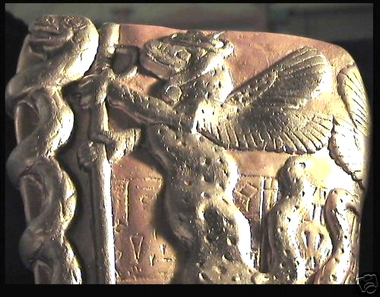
The original Wallans were apparent in Mesopotamia around 3,800 years ago, in about 1800 BC. They were called the Yulannu, which meant, quite simply, Wood Lords. Indeed, it was from their culture that the original Yule tradition derived, subsequently making its way across Europe to Scandinavia.
The venerated Goddess of the Yulannu was Barat An-na (Great Mother of the Fire-stone). The Sumerians called her Antu. She was the wife of the god Anu, and the mother of Enki. In later times, she was identified with Diana of Ephesus (Diana of the Nine Fires). The cult of Barat An-na spread across Syria into the Phoenician kingdom, where they began to portray her on their coins. In these representations, she sat by the seashore with a torch of fire, and at her side was a round shield bearing the cross of the Rosi-crucis.
Along with the Wallan Druids, the culture of Barat An-na was brought to the British islands, where her name became compacted to Bratanna. And in those islands, her image persisted to the extent that she became the great tribal goddess - a goddess who, despite all the emergent centuries of Christianity, has prevailed to this very day. Her image on the coins has barely altered, except that her flaming torch became a lighthouse, and the Rosi-crucis cross of her shield was amended to become the Union Jack. But, after all this time, she is still the Mother Goddess of the land, the Lady of the Fire-stone: Britannia. (Gardner)
King Casswallan who reigned in Britain at about the time of King Herod the Great. By virtue of being the son of the great Beli Mawr, he was not only a Wood Lord but was also a Ring Lord of the Cassi; hence, he was Cassi-Wallan or Casswallan. The Cassi tribes were also from Mesopotamia, prior to which (having previously settled in the northern Zargos Mountains along with the Yulannu) they were Carpathian princes of the Sidhé. They were, in fact, of the Tuatha Dé Danann Fairy strain. They reigned in regional Mesopotamia from the 18th century BC and, from about 1600 BC, they governed all Babylonia for another 500 years.
This particular race developed one of the oldest Ring cultures in history and, in ancient Ireland, they were the sacred race of the god-men: the Vere-Bolg. The greatest of their Ring shrines still exists, known as Newgrange today - originally a sacred royal seat identified as a Rath. These shrines ("fairy rings") were called the Creachaire (temple-tombs), and they housed the Raths which were turf-covered mound dwellings constructed upon a framework of poles. In later times, they were called Tepes (pronounced "tepesh") - from which derived the American Indian tepee - and they were reckoned to be Portals to the Netherworld, the sacred domain of ancestral souls. It is from this mound-dwelling practice that the tribal name of the Cassi Kings evolved, for a Cassi was a Place of Wood. They were the seats of the Portal Guardians: the Oupires, the Ring Lords of the Sidhé, who, as we saw earlier, were later dubbed "vampires".
One of history's best known Grail Fairies was Princess Melusine, daughter of the Pictish King, Elinas of Alba - a descendant of the 2nd-century King Vere of Caledonia, Lord of the Dragon. In the year 733, Melusine (maintaining the family heritage) married Rainfroi de Vere, Prince of Anjou, and among their offspring was Count Maelo, the commander of Emperor Charlemagne's army. From Maelo's own marriage to Charlemagne's sister sprang the Vere Counts of Guisnes who, as previously mentioned, were the reputed Elf Kings and became England's Great Chamberlains and Earls of Oxford.
In the Arthurian and Magdalene traditions of the Ladies of the Lake (as discussed in Bloodline of the Holy Grail), Melusine was a "fountain fey" - an enchantress of the Underwood. Her fountain at Verrières en Forez was called Lusina (meaning "Light-bringer"), from which derived the name of the Royal House of Lusignan - the Crusader Kings of Jerusalem. The Fount of Melusine was said to be located deep within a thicket wood in Anjou, and Melusine was often depicted as a mermaid - as she is still beguilingly portrayed in an old painting at Count Dracula's Bran Castle in Romania.
In the 12th-century, Melusine's descendant, Robert de Vere, 3rd Earl of Oxford and legal pretender to the Earldom of Huntingdon, was appointed as King Richard I's Steward of the forest lands of Fitzooth. As Lord of the Greenwood and titular Herne of the Wild Hunt, he was a popular people's champion of the Sidhé heritage - as a result of which he was outlawed for taking up arms against King John. It was he who, subsequently styled Robin Fitzooth, became the prototype for the popular tales of Robin Hood.
The true significance of King Arthur was his immediate joint descent in both the male and female lines of the Albi-gens. His father was King Aedàn of Dalriada, the Pendragon of Britain in the year 559 and a descendant of the Wood Lord Beli Mawr. His mother was Ygerna del Acqs, the daughter of Queen Viviane, whose grandson (by Ygerna's sister, Viviane II) was the legendary Lancelot del Acqs. Ygerna (sometimes called Igraine in the Grail tradition) was the High Queen of the Celtic kingdoms, and her daughter Morgaine (by her first husband, Gwyr Llew of Carlisle) was High Priestess of the Sisters of Avallon.
Over the years, there have been any number of speculations concerning the historical Arthur, but these are mainly fronted by tourist establishments endeavoring to claim the Arthurian heritage for their particular parts of England or Wales. The fact is, however, that (in line with the traditional accounts) there was only ever one High King of Britain called Arthur. There was only ever one Arthur born as the son of a Pendragon. There was only ever one Arthur whose mother was Igraine of Avallon and whose grandmother was the recognized Lady of the Lake. There was only ever one Arthur with a son named Modred, and there was only ever one Arthur with a sister called Morgaine (or Morgana).
In this regard, the old annals of Scotland and Ireland, along with the records of the Celtic Church, are unanimous in identifying Arthur mac Aedàn of Dalriada. He was invested as Sovereign Commander and High King in the year 575 by the Druid, Merlin Emrys, and his primary seat was at Carlisle in the north of England, from where he controlled the military defense of the English-Scottish border country. (Gardner)
Of particular interest is the fact that the Anunnaki gods were as much a part of the Sidhé culture as they were of the Mesopotamian tradition. It was not for no reason that the settlement of Anu was hundreds of miles north of Sumer on the Caspian Sea. It was not for no reason that the ancient centre of Scythopolis (Sidhé-opolis), which the Syrians called Beth-Shean (the House of Power), was 800 miles away in Galilee. Indeed, it is now suspected that the Ubaid culture of southern Mesopotamia - the culture which introduced municipal structure from about 5000 BC - was actually the Uper-ad culture: that of the Scythian Overlords, the Upers or Oupires.
It is also reckoned that the subsequent culture of the region, phonetically called Sumerian (pronounced "Shumerian"), was actually Sidhé-murian ("Shee-murian"). In fact, the case for this is now considerable, since the early Ring Lords of Scythia (the Tuatha Dé Danann king-tribe) were actually called the Sumaire. And in the language of old Ireland - to where many of the caste migrated - the word sumaire means "dragon". (de Vere)
CELTIC DRUIDS: http://books.google.com/books?id=wrokoJL63OwC&pg=PA288&lpg=PA288&dq=serpentine+%22serpent%27s+egg%22&source=bl&ots=9auHZHgEIl&sig=OQedpkQrfPIHOPHrtpSpIryCgLo&hl=en&ei=FLTdTOTtB8SA4QaNoeg6&sa=X&oi=book_result&ct=result&resnum=2&sqi=2&ved=0CBkQ6AEwAQ#v=onepage&q=serpentine%20%22serpent%27s%20egg%22&f=false
The venerated Goddess of the Yulannu was Barat An-na (Great Mother of the Fire-stone). The Sumerians called her Antu. She was the wife of the god Anu, and the mother of Enki. In later times, she was identified with Diana of Ephesus (Diana of the Nine Fires). The cult of Barat An-na spread across Syria into the Phoenician kingdom, where they began to portray her on their coins. In these representations, she sat by the seashore with a torch of fire, and at her side was a round shield bearing the cross of the Rosi-crucis.
Along with the Wallan Druids, the culture of Barat An-na was brought to the British islands, where her name became compacted to Bratanna. And in those islands, her image persisted to the extent that she became the great tribal goddess - a goddess who, despite all the emergent centuries of Christianity, has prevailed to this very day. Her image on the coins has barely altered, except that her flaming torch became a lighthouse, and the Rosi-crucis cross of her shield was amended to become the Union Jack. But, after all this time, she is still the Mother Goddess of the land, the Lady of the Fire-stone: Britannia. (Gardner)
King Casswallan who reigned in Britain at about the time of King Herod the Great. By virtue of being the son of the great Beli Mawr, he was not only a Wood Lord but was also a Ring Lord of the Cassi; hence, he was Cassi-Wallan or Casswallan. The Cassi tribes were also from Mesopotamia, prior to which (having previously settled in the northern Zargos Mountains along with the Yulannu) they were Carpathian princes of the Sidhé. They were, in fact, of the Tuatha Dé Danann Fairy strain. They reigned in regional Mesopotamia from the 18th century BC and, from about 1600 BC, they governed all Babylonia for another 500 years.
This particular race developed one of the oldest Ring cultures in history and, in ancient Ireland, they were the sacred race of the god-men: the Vere-Bolg. The greatest of their Ring shrines still exists, known as Newgrange today - originally a sacred royal seat identified as a Rath. These shrines ("fairy rings") were called the Creachaire (temple-tombs), and they housed the Raths which were turf-covered mound dwellings constructed upon a framework of poles. In later times, they were called Tepes (pronounced "tepesh") - from which derived the American Indian tepee - and they were reckoned to be Portals to the Netherworld, the sacred domain of ancestral souls. It is from this mound-dwelling practice that the tribal name of the Cassi Kings evolved, for a Cassi was a Place of Wood. They were the seats of the Portal Guardians: the Oupires, the Ring Lords of the Sidhé, who, as we saw earlier, were later dubbed "vampires".
One of history's best known Grail Fairies was Princess Melusine, daughter of the Pictish King, Elinas of Alba - a descendant of the 2nd-century King Vere of Caledonia, Lord of the Dragon. In the year 733, Melusine (maintaining the family heritage) married Rainfroi de Vere, Prince of Anjou, and among their offspring was Count Maelo, the commander of Emperor Charlemagne's army. From Maelo's own marriage to Charlemagne's sister sprang the Vere Counts of Guisnes who, as previously mentioned, were the reputed Elf Kings and became England's Great Chamberlains and Earls of Oxford.
In the Arthurian and Magdalene traditions of the Ladies of the Lake (as discussed in Bloodline of the Holy Grail), Melusine was a "fountain fey" - an enchantress of the Underwood. Her fountain at Verrières en Forez was called Lusina (meaning "Light-bringer"), from which derived the name of the Royal House of Lusignan - the Crusader Kings of Jerusalem. The Fount of Melusine was said to be located deep within a thicket wood in Anjou, and Melusine was often depicted as a mermaid - as she is still beguilingly portrayed in an old painting at Count Dracula's Bran Castle in Romania.
In the 12th-century, Melusine's descendant, Robert de Vere, 3rd Earl of Oxford and legal pretender to the Earldom of Huntingdon, was appointed as King Richard I's Steward of the forest lands of Fitzooth. As Lord of the Greenwood and titular Herne of the Wild Hunt, he was a popular people's champion of the Sidhé heritage - as a result of which he was outlawed for taking up arms against King John. It was he who, subsequently styled Robin Fitzooth, became the prototype for the popular tales of Robin Hood.
The true significance of King Arthur was his immediate joint descent in both the male and female lines of the Albi-gens. His father was King Aedàn of Dalriada, the Pendragon of Britain in the year 559 and a descendant of the Wood Lord Beli Mawr. His mother was Ygerna del Acqs, the daughter of Queen Viviane, whose grandson (by Ygerna's sister, Viviane II) was the legendary Lancelot del Acqs. Ygerna (sometimes called Igraine in the Grail tradition) was the High Queen of the Celtic kingdoms, and her daughter Morgaine (by her first husband, Gwyr Llew of Carlisle) was High Priestess of the Sisters of Avallon.
Over the years, there have been any number of speculations concerning the historical Arthur, but these are mainly fronted by tourist establishments endeavoring to claim the Arthurian heritage for their particular parts of England or Wales. The fact is, however, that (in line with the traditional accounts) there was only ever one High King of Britain called Arthur. There was only ever one Arthur born as the son of a Pendragon. There was only ever one Arthur whose mother was Igraine of Avallon and whose grandmother was the recognized Lady of the Lake. There was only ever one Arthur with a son named Modred, and there was only ever one Arthur with a sister called Morgaine (or Morgana).
In this regard, the old annals of Scotland and Ireland, along with the records of the Celtic Church, are unanimous in identifying Arthur mac Aedàn of Dalriada. He was invested as Sovereign Commander and High King in the year 575 by the Druid, Merlin Emrys, and his primary seat was at Carlisle in the north of England, from where he controlled the military defense of the English-Scottish border country. (Gardner)
Of particular interest is the fact that the Anunnaki gods were as much a part of the Sidhé culture as they were of the Mesopotamian tradition. It was not for no reason that the settlement of Anu was hundreds of miles north of Sumer on the Caspian Sea. It was not for no reason that the ancient centre of Scythopolis (Sidhé-opolis), which the Syrians called Beth-Shean (the House of Power), was 800 miles away in Galilee. Indeed, it is now suspected that the Ubaid culture of southern Mesopotamia - the culture which introduced municipal structure from about 5000 BC - was actually the Uper-ad culture: that of the Scythian Overlords, the Upers or Oupires.
It is also reckoned that the subsequent culture of the region, phonetically called Sumerian (pronounced "Shumerian"), was actually Sidhé-murian ("Shee-murian"). In fact, the case for this is now considerable, since the early Ring Lords of Scythia (the Tuatha Dé Danann king-tribe) were actually called the Sumaire. And in the language of old Ireland - to where many of the caste migrated - the word sumaire means "dragon". (de Vere)
CELTIC DRUIDS: http://books.google.com/books?id=wrokoJL63OwC&pg=PA288&lpg=PA288&dq=serpentine+%22serpent%27s+egg%22&source=bl&ots=9auHZHgEIl&sig=OQedpkQrfPIHOPHrtpSpIryCgLo&hl=en&ei=FLTdTOTtB8SA4QaNoeg6&sa=X&oi=book_result&ct=result&resnum=2&sqi=2&ved=0CBkQ6AEwAQ#v=onepage&q=serpentine%20%22serpent%27s%20egg%22&f=false
Sects & the Sidhe
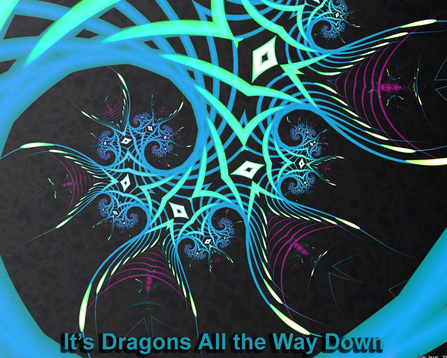
Above from Works of Edmund Spenser
Sects & the Sidhe
The 'Atlanteans' originated in Transylvania or "Little Scythia" and were the forebearers of Sumerians and Egyptians and northern Europeans in the Golden Age preceding the deluge. The lineage came to Scotland via Princess Scota of the Egyptian Dragon Court, ancestor of Princess Milouziana (Melusine) of the Scythians, a powerful witch, fairy and Dragon Princess of the Scottish Picts descending from King Vere.Her grandson, Prince Milo II, intermarried with senior lines of the Merovingian descent of the Frankish Kings.The matriineal Dragon Queen empowered the Grail King.
According to Nicholas de Vere, "Briefly, the Dragon lineage starts in the Caucasus with the Annunaki, descending through migrating proto-Scythians to the Sumerians while branching off also into the early Egyptians, Phoenicians and Mittani. A marriage bridge back to Scythia infused the Elvin line of “Tuatha de Danaan” and the Fir Bolg, which branched into the Arch-Druidic, Priest-Princely family to the Royal Picts of Scotland and the ring kings of the Horse Lords of Dal Riada, through the Elven dynasty of Pendragon and Avallon del Acqs, and down to a few pure bred families today."
When the Ionian priestesses feared invasion by lesser magical elements, they brought into their sacred stronghold certain Druids who were aligned to their spiritual principles. The Druids remained on Iona after the priestess-hood had departed.Throughout its history, Iona has been known to be a “thin place” where the veil between worlds can be traversed, a place where the sense of the sacred seems more pronounced than in more mundane parts of the world. Annwfn is the name of the Celtic Otherworld. The Dragon lineage is known first and foremost as Seers or prophets, whose clarity of vision is legendary. Magic was the spiritual technology of the Sidhe, who had genetics which amplified their psychic capacities. There is still a Celtic Church of the Sacred Kindred of St. Columba associated with the dragon lineage.
Sects & the Sidhe
The 'Atlanteans' originated in Transylvania or "Little Scythia" and were the forebearers of Sumerians and Egyptians and northern Europeans in the Golden Age preceding the deluge. The lineage came to Scotland via Princess Scota of the Egyptian Dragon Court, ancestor of Princess Milouziana (Melusine) of the Scythians, a powerful witch, fairy and Dragon Princess of the Scottish Picts descending from King Vere.Her grandson, Prince Milo II, intermarried with senior lines of the Merovingian descent of the Frankish Kings.The matriineal Dragon Queen empowered the Grail King.
According to Nicholas de Vere, "Briefly, the Dragon lineage starts in the Caucasus with the Annunaki, descending through migrating proto-Scythians to the Sumerians while branching off also into the early Egyptians, Phoenicians and Mittani. A marriage bridge back to Scythia infused the Elvin line of “Tuatha de Danaan” and the Fir Bolg, which branched into the Arch-Druidic, Priest-Princely family to the Royal Picts of Scotland and the ring kings of the Horse Lords of Dal Riada, through the Elven dynasty of Pendragon and Avallon del Acqs, and down to a few pure bred families today."
When the Ionian priestesses feared invasion by lesser magical elements, they brought into their sacred stronghold certain Druids who were aligned to their spiritual principles. The Druids remained on Iona after the priestess-hood had departed.Throughout its history, Iona has been known to be a “thin place” where the veil between worlds can be traversed, a place where the sense of the sacred seems more pronounced than in more mundane parts of the world. Annwfn is the name of the Celtic Otherworld. The Dragon lineage is known first and foremost as Seers or prophets, whose clarity of vision is legendary. Magic was the spiritual technology of the Sidhe, who had genetics which amplified their psychic capacities. There is still a Celtic Church of the Sacred Kindred of St. Columba associated with the dragon lineage.
They Honor the Fire & Light
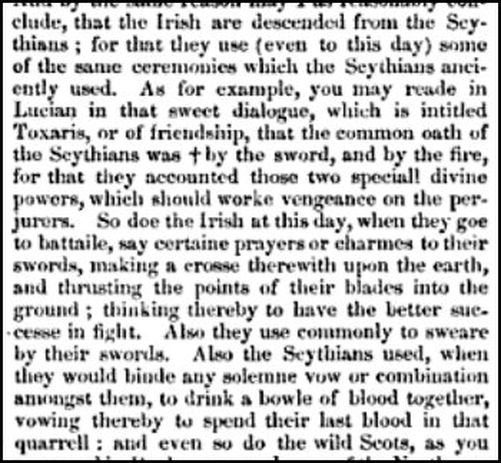
Some sects of Druids were quite bloodthirsty in nature, while others, like the Ionian Druids, refused the tenets of sacrifice, wishing only to worship nature in her purest and undefiled form. These ‘purists' were descended from the original Atlantean Dorrids, who were known in Atlantis as ‘Priests and Priestesses of the Earth'.
The ancient Siddhi, or Seers are of royal Scythian (pronounced "SITH-eee-an") blood. The nomadic culture spawned the Sarmatian, Hun, Khazar, and Mongolian empires. Their Elven magic is the root of all other imitative rites that seek to emulate Dragon Consciousness. "The name Sithian is related to a group of words that appear in Indo-European languages which are found as far apart as Eire and Northern India, indicating that they had a common Aryan origin in Scythia. These include - Sithia, Sidhe, Siddir and Siddhi."
"The curious Irish word - Sidhe - pronounced ’shee’, ’sheeth’ or ’sheeth-ay’ is attributed to the fairies and means ’powers’. It is therefore identical to Siddir (sheeth-eer) and Siddhi (sheeth-ee) and is derived therefore, from the people of the powers - the Scythians or Sidheans (sheethee-ans). In Scotland the royal fairies were called the Seelie or Sheelie. . .goddesses of sovereignty and transcendence. . .Along with the Irish Sidhe, the Seelie and the Seelie Court of Scotland had a distinctly royal origin in the Tuadha d’Anu who when asked, like their Pictish descendants in Scotland, said of themselves that they were Scythian." The occult arcana, de Vere claims, are lower rites imitating the original practice of the Druidic/Vampiric/Elven line, he characterizes as a separate species.
The Sidhé was a transcendent intellect, known to the Druids as the Web of the Wise, while "druid" (druidhe) was itself a Celtic word for "witch" - an English form of the Saxon verb wicca, meaning "to bend" or "to yield" (as indeed do willow and wicker).
The Tuatha Dé Danann (or Dragon Lords of Anu) were masters of the transcendent Sidhé, and were duly classified as "fates" or "fairies". Before settling in Ireland (from about 800 BC), they were the world's most noble race, alongside the early Kings of Egypt, being the Black Sea Princes of Scythia (now Ukraine). Like the original dynastic Pharaohs, they traced their descent from the great Pendragons of Mesopotamia; and from them sprang the kingly lines of the Irish Bruithnigh and the Picts of Scotland's Caledonia. In Wales they founded the Royal House of Gwynedd, while in Cornwall in the southwest of England, they were the sacred gentry known as the Pict-sidhé - from which derives the term "pixie".
So, from a single caste of the original Blood Royal - whether known as the Sangréal, the Albi-gens or the Ring Lords - we discover many of the descriptive terms which sit at the very heart of popular folklore. For here, in this one noble race, we have the "elves", "fairies" and "pixies" - not beguiling little folk, but distinguished Kings and Queens of the Dragon succession.
One of the most important Scythian words was uper, which meant "over" or "above" - a word that we still use in today's English in such definitions as "superintendent" or "supervisor". In titular form, a Scythian Uper was an Overseer or, more importantly, an Overlord - the equivalent of a Pendragon. Later, in the Hungarian and Romanian regions, the word gained the variant form, Oupire.
Until the mediaeval fabrications of the Christian Church, there was nothing remotely sinister or supernatural about the definition of Oupire, but this was eventually destined to change when the witch-hunts began, for the priestly/kingly Oupires were, in the eyes of Rome, the equivalent of Magian Druids. They were therefore witches, and the Sidhé definition (Web of the Wise) became newly dubbed as "the Web of the Weird".
In the main, outside the Celtic regions of Britain, the traditional Oupires had been apparent in the Balkan and Carpathian regions of Europe, having prevailed from Transylvania to the Black Sea in ancient times. They were therefore not only associated with witches but with Gypsies.
The Church bishops and Inquisitional friars suspected them of being the ultimate rulers of the Land of Elphane - the twilight realm of fairy gold, magic springs and the abiding lore of the Greenwood, all of which were anathema to the Church. They were said to be wandering people of the night, who consorted with evil spirits. At that stage, a new word was born into the language of Christian Europe. The word, a straightforward corruption of Oupire, was "vampire".
In addition to vampires, another classification was soon to enter the Inquisitional vocabulary as the Dominican Black Friars and the Franciscan Grey Friars compiled their lists of undesirables. They had now moved beyond the realm of ordinary heretics and pagans, for alongside their fabricated vampire myth they conjured another form of shape-shifting phenomenon: the werewolf. (Gardner)
Edmund Spenser wrote that "the Chiefest [nation that settled in Ireland] I Suppose to be Scithians ... which firste inhabitinge and afterwarde stretchinge themselves forthe into the lande as theire numbers increased named it all of themselues Scuttenlande which more brieflye is Called Scuttlande or Scotlande" (A View of the Present State of Ireland, c. 1596). Among the proofs Spenser names for this origin are the alleged Irish customs of blood-drinking, nomadic lifestyle, the wearing of mantles and certain haircuts and "Cryes [or wailings] allsoe vsed amongeste the Irishe which savor greatlye of the Scythyan Barbarisme". William Camden, one of Spenser's main sources, comments on this myth of origin that "to derive descent from a Scythian stock, cannot be thought any waies dishonourable, seeing that the Scythians, as they are most ancient, so they have been the Conquerours of most Nations, themselves alwaies invincible, and never subject to the Empire of others" (Britannia, 1586 etc., Engl. transl. 1610).
The Irish were long referred to as Scots even before some of them migrated to the country that today bears their name, and as Brewer tells us: 'Scot (is) the same as Scythian in etymology; the root of both is Sct. The Greeks had no c, and would change t into th making the root skth, and by adding a phonetic vowel we get Skuthai (Scythians), and Skodiai (Skoths). The Welsh disliked s at the beginning of a word, and would change it to ys; they would also change c or k to g, and th to d; whence the Welsh root would be Ysgd, and Skuth or Skoth would become ysgod. Once more, the Saxons would cut off the Welsh y, and change the g back again to c, and the d to t, converting the Ysgod to Scot.'
The German word for both Scottish and Scythian is "Scutten". The Celts been regarded as descended from Gomer, though history suggests modern Celts are descended from both Gomer and Magog. Archaeologists and ethnologists agree that the first Indo-European group to spread across Europe were Celts. The Irish Celts claim to be to the descendants of Magog, while the Welsh Celts claim to be to the descendants of Gomer. Irish chronicles, genealogies, plus an extensive number of manuscripts which have survived from ancient times, reveal their roots.
The Irish were descendants of Scythians, also known as Magogians, which is strongly supported by etymological evidence. Archaeological evidence shows that both the Celts (from Gomer) and Scythians (from Magog) freely shared and mingled cultures at their earliest stages. Russian and eastern European excavations plainly reveal the blending of these two groups. Their geographical locations (what is now eastern Europe, southern Russia and Asia Minor) were referred to by the Greeks under the name of Celto-Scythae, which was populated by the Celts to the south and west, and the Scythians to the north.
The ancient Greeks first called the northern peoples "Scuthes" and by the general name of Scythae from which rose the tribal name "Scot" in both Gaelic and English. When the Greeks became acquainted with the nations in the west, they began to call them by the different names of Celts, including the Celto-Scythae. Celts and Scythians were considered essentially the same peoples, based on geography, though many independent tribes of Celts and Scythians existed. The Latins called them "Galli," and the Romans referred to them as "Gauls."
Later names used by Greeks were the Galatai or Galatae, Getae, Celtae and Keltoi. In the third century before Christ (about 280 B.C.), the Gauls invaded Rome and were ultimately repelled into Greece, where they migrated into the north-central part of Asia Minor (Anatolia). Known as fiercely independent peoples, they conquered the indigenous peoples of that region and established their own independent kingdom. The land became known as Galatia. The Apostle Paul wrote his famous epistle to their descendants, the Galatians. Jewish historian Flavius Josephus wrote that the Galatians or Gauls of his day (93 A.D.) were previously called Gomerites.
Early Celtic tribes (from Gomer) settled much of the European theater, including present-day Spain, France, England and Germany, prior to contact with Scythians. For many centuries France was called Gaul, after the Celtic descendants of Gomer, whom ceded the territory to Romans and Germanic/Teutonic Franks (whence France) in the 4th century A.D. Northwest Spain is called Galicia to this day. Some of the Gomerites migrated further to what is now called Wales. The Welsh claim their ancestors "first landed on the Isle of Britain from France, about three hundred years after the flood." The Celtic language survives intact today mainly in the two variants of Welsh and Irish/Scottish Gaelic. The Welsh call their language Gomeraeg (after Gomer). The Celts of today are descendants of Gomer, and of the blended tribes of Magog and Gomer.
The Declaration of Arbroath was written in Latin and promulgated on April 6th, 1320, at Arbroath Abbey (on the east coast of Scotland, just north of St. Andrews, the home of golf). Its purpose was to convince Pope John XXII, resident in Avignon, France, that Scotland was an independent country. This rebutted the English claim to rule Scotland. Famed Scottish leader, Robert the Bruce, had defeated the English at Bannockburn in 1314, and recaptured Berwick-on-Tweed (a city on the border with England) from the English in 1319.Particularly interesting is that the Declaration claims a connection between the Scots and the Scythians, and also mentions the Exodus of the Children of Israel from Egypt. The ancient tribe of the Scythians once lived in the area to which the "Lost Ten Tribes of Israel" were deported by the Assyrian Empire (according to the Bible and historical sources).Another Scottish connection to the Scythians is that, according to legend, Andrew, one of Christ's apostles, preached to the Scythians. St. Andrew is the patron saint of Scotland. The Scottish flag contains a Cross of Saint Andrew. --"The Declaration of Arbroath" by Sir James Fergusson, Edinburgh University Press, 1970
Most Holy Father and Lord, we know and from the chronicles and books of the ancients we find that among other famous nations our own, the Scots, has been graced with widespread renown. They journeyed from Greater Scythia by way of the Tyrrhenian Sea and the Pillars of Hercules, and dwelt for a long course of time in Spain among the most savage tribes, but nowhere could they be subdued by any race, however barbarous. Thence they came, twelve hundred years after the people of Israel crossed the Red Sea, to their home in the west where they still live today. The Britons they first drove out, the Picts they utterly destroyed, and, even though very often assailed by the Norwegians, the Danes and the English, they took possession of that home with many victories and untold efforts; and, as the historians of old time bear witness, they have held it free of all bondage ever since. In their kingdom there have reigned one hundred and thirteen kings of their own royal stock, the line unbroken a single foreigner.
The Dragon Legacy: http://books.google.com/books?id=06FkpD0ihzMC&pg=PA16&lpg=PA16&dq=princess++scota+Dragon+lineage&source=bl&ots=rWm4D7GAEV&sig=dKWWGHvnRR3qrm3MCyDUfJwOZNI&hl=en&ei=rJ7ZTIq3F43AsAPPjrnQBw&sa=X&oi=book_result&ct=result&resnum=2&sqi=2&ved=0CBYQ6AEwAQ#v=onepage&q=princess%20%20scota%20Dragon%20lineage&f=false
REALM OF THE RING LORDS: http://books.google.com/books?id=HNWpxJwBxmUC&printsec=frontcover&dq=elves+laurence+gardner&source=bl&ots=GdBkhd29Ha&sig=a1TT4U3nc0nEz7LKxm8jqqQOD3Y&hl=en&ei=dlfbTKvRKo68sQOwmOjYBw&sa=X&oi=book_result&ct=result&resnum=3&ved=0CCgQ6AEwAg#v=onepage&q=elves%20laurence%20gardner&f=false
Magical Mystical Site
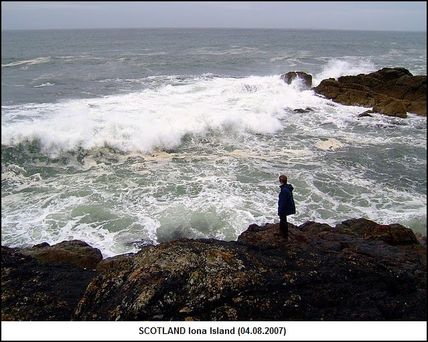
Iona is akin to certain Welsh holy isles that were also Druid strongholds. Mona and Holy Island are not the only sacred island in the Anglesey area. On a fine day, you can see Bardsey Island in the distance, an island whose very name is linked with the “bards” – the druids. And it is an island that is equally held to be sacred, and even identified as the real Avalon. But, "Island under the Sea" is another word for 'Avalon'. Legends state that Bardsey Island, also known as Ynys Enlli, is identified as the last resting place of Merlin the Magician, the archetypal druid.
Bardsey Island was the site where druids and “Celtic royalty” were buried, or whether it was here that druids perhaps also retired to, in preparation for their eventual death. Legend had it that anybody buried on Bardsey was guaranteed eternal salvation. Furthermore, the place has always been considered something of a health spot. Giraldus Cambrensis in his "Itinerary through Wales" of 1188 wrote: "beyond Lleyn, there is a small island inhabited by very religious monks called Caelibes or Colidei. This island, either from the healthiness of its climate, or rather from some miracle and the merits of the Saints, has this wonderful peculiarity that the oldest people die first, because diseases are uncommon, and scarcely any die except from extreme old age. Its name is Enlli, in the Welsh, and Berdesey, in the Saxon language." Such descriptions contributed to the island’s identification with Avalon.
Certainly Iona is alive with the mists of its past. In ‘Magical and Mystic Sites' Elizabeth Pepper and John Wilcock write of Iona:
"The colors of sea and sky are pristine, the beaches are of white sand, and great patches of wild daffodils turn the island into a blaze of yellow each spring. At both ends of the island the lovely low hills with their score of secret glens and hollows must hide a thousand memories of age old ceremonials or gatherings under the moon. At dusk, even today, they seem to be haunted by spirits of long ago. The turf is chopped short everywhere by the ranging sheep, but the ground has probably never been uncovered to reveal the ancient treasures that must lie beneath.
"Iona feels old: the air, the ground, the contours of the land seem saturated with ancient memories. Possibly because of its remoteness (no cars are allowed on the island), the island seems to shun contemporary life. The air is fresh and energizing but has the sweet aroma of hidden secrets; the ground is often rutted as though hundreds of thousands of feet have traversed the same routes."
In ‘Magical and Mystical Sites' we read:
"....the Anglo-American mystic Col. James Churchward, in The Lost Continent of Mu, speculated that the original Druids were descended from Egyptian priests who landed in Ireland and the west of England, bringing with them all their ancient beliefs in sun worship."
Certainly Egyptian beliefs were to be found within the Druid practice, but Egypt was originally a colony of Atlantis, the true source of the Druids. Iona's ancient body called the Atlanteans to its shore as if it sang a siren song to those who had suffered the loss of their sacred space. Iona's jeweled beaches bespoke the same olden rhyme of the Ancient Ones in the soft drumming of its surf and the circling cries of the gulls.
From the book ‘Iona', by John L. Patterson, we read:
"The rocks of Iona are little older than the ocean from which they rise. The Reverend Edward Craig Trenholme in The Story of Iona (1909) has written: ‘When our planet from a glowing mass of combustion like the sun, shriveled into a globe with a solid crust and the first oceans condensed in the hollows of its hot surface - then it was that the Archaean rocks, of which Iona and the Outer Hebrides consist, were formed on the sea bottom. They contain no fossils, for, as far as is known, no living creatures as yet existed in the desolate waste of waters or on the primeval land. They are hard, rugged and twisted, and in Iona as elsewhere marble had been developed by the vast heat and pressure they have undergone.'
"On Iona the rocks are always with you for they are only partly hidden by a thin veneer of turf and heather and you can sense their antiquity when your path is impeded by the presence of their implacable solidity. To fully appreciate the age of this part of the Earth's surface you must climb to the summit of Dun I and survey the surrounding terrain. That early settlers were prepared to live in this remote and primeval part of the world appears perverse but there is some evidence that ancient rocks possessed magical qualities for the old religions; and Iona, for this reason, may have been chosen as a centre by the Druids for their rituals. It is thought that Dun I may possibly have been used for their primitive rites and it is not difficult to imagine, when standing on such a commanding site, that it would have appeared to them to have been the centre of the world."
On Iona, the Priestesses of Ank welcomed individuals into their sanctuary for periods of instruction and often healing. Those brought to the island were selected through a process which included scrying. Scrying is the magical art of viewing events at a distance in time and space through a reflective element such as water, crystal or a polished surface. An astral initiation is giving spiritual initiation into inner-plane learning while in out-of-body experience. Many who came to Iona came not in the physical body. The Ank Priestess-hood opened several layers of the etheric over this isle, some of which remains loosely formed to this day. Thus, there are many astral presences still moving upon the surface of the Island of the Druids.
BRIEF HISTORY OF THE DRUIDS: http://books.google.com/books?id=PIXAREdVI_QC&pg=PA60&lpg=PA60&dq=%22serpent%27s+egg%22+druids&source=bl&ots=PVqiSq-Em0&sig=vRqzPD9PB2kAZPU2FP6ZpXqBeBE&hl=en&ei=pE_cTM-IOpP0swOgvL3iBw&sa=X&oi=book_result&ct=result&resnum=8&sqi=2&ved=0CEMQ6AEwBw#v=onepage&q=%22serpent%27s%20egg%22%20druids&f=false
Bardsey Island was the site where druids and “Celtic royalty” were buried, or whether it was here that druids perhaps also retired to, in preparation for their eventual death. Legend had it that anybody buried on Bardsey was guaranteed eternal salvation. Furthermore, the place has always been considered something of a health spot. Giraldus Cambrensis in his "Itinerary through Wales" of 1188 wrote: "beyond Lleyn, there is a small island inhabited by very religious monks called Caelibes or Colidei. This island, either from the healthiness of its climate, or rather from some miracle and the merits of the Saints, has this wonderful peculiarity that the oldest people die first, because diseases are uncommon, and scarcely any die except from extreme old age. Its name is Enlli, in the Welsh, and Berdesey, in the Saxon language." Such descriptions contributed to the island’s identification with Avalon.
Certainly Iona is alive with the mists of its past. In ‘Magical and Mystic Sites' Elizabeth Pepper and John Wilcock write of Iona:
"The colors of sea and sky are pristine, the beaches are of white sand, and great patches of wild daffodils turn the island into a blaze of yellow each spring. At both ends of the island the lovely low hills with their score of secret glens and hollows must hide a thousand memories of age old ceremonials or gatherings under the moon. At dusk, even today, they seem to be haunted by spirits of long ago. The turf is chopped short everywhere by the ranging sheep, but the ground has probably never been uncovered to reveal the ancient treasures that must lie beneath.
"Iona feels old: the air, the ground, the contours of the land seem saturated with ancient memories. Possibly because of its remoteness (no cars are allowed on the island), the island seems to shun contemporary life. The air is fresh and energizing but has the sweet aroma of hidden secrets; the ground is often rutted as though hundreds of thousands of feet have traversed the same routes."
In ‘Magical and Mystical Sites' we read:
"....the Anglo-American mystic Col. James Churchward, in The Lost Continent of Mu, speculated that the original Druids were descended from Egyptian priests who landed in Ireland and the west of England, bringing with them all their ancient beliefs in sun worship."
Certainly Egyptian beliefs were to be found within the Druid practice, but Egypt was originally a colony of Atlantis, the true source of the Druids. Iona's ancient body called the Atlanteans to its shore as if it sang a siren song to those who had suffered the loss of their sacred space. Iona's jeweled beaches bespoke the same olden rhyme of the Ancient Ones in the soft drumming of its surf and the circling cries of the gulls.
From the book ‘Iona', by John L. Patterson, we read:
"The rocks of Iona are little older than the ocean from which they rise. The Reverend Edward Craig Trenholme in The Story of Iona (1909) has written: ‘When our planet from a glowing mass of combustion like the sun, shriveled into a globe with a solid crust and the first oceans condensed in the hollows of its hot surface - then it was that the Archaean rocks, of which Iona and the Outer Hebrides consist, were formed on the sea bottom. They contain no fossils, for, as far as is known, no living creatures as yet existed in the desolate waste of waters or on the primeval land. They are hard, rugged and twisted, and in Iona as elsewhere marble had been developed by the vast heat and pressure they have undergone.'
"On Iona the rocks are always with you for they are only partly hidden by a thin veneer of turf and heather and you can sense their antiquity when your path is impeded by the presence of their implacable solidity. To fully appreciate the age of this part of the Earth's surface you must climb to the summit of Dun I and survey the surrounding terrain. That early settlers were prepared to live in this remote and primeval part of the world appears perverse but there is some evidence that ancient rocks possessed magical qualities for the old religions; and Iona, for this reason, may have been chosen as a centre by the Druids for their rituals. It is thought that Dun I may possibly have been used for their primitive rites and it is not difficult to imagine, when standing on such a commanding site, that it would have appeared to them to have been the centre of the world."
On Iona, the Priestesses of Ank welcomed individuals into their sanctuary for periods of instruction and often healing. Those brought to the island were selected through a process which included scrying. Scrying is the magical art of viewing events at a distance in time and space through a reflective element such as water, crystal or a polished surface. An astral initiation is giving spiritual initiation into inner-plane learning while in out-of-body experience. Many who came to Iona came not in the physical body. The Ank Priestess-hood opened several layers of the etheric over this isle, some of which remains loosely formed to this day. Thus, there are many astral presences still moving upon the surface of the Island of the Druids.
BRIEF HISTORY OF THE DRUIDS: http://books.google.com/books?id=PIXAREdVI_QC&pg=PA60&lpg=PA60&dq=%22serpent%27s+egg%22+druids&source=bl&ots=PVqiSq-Em0&sig=vRqzPD9PB2kAZPU2FP6ZpXqBeBE&hl=en&ei=pE_cTM-IOpP0swOgvL3iBw&sa=X&oi=book_result&ct=result&resnum=8&sqi=2&ved=0CEMQ6AEwBw#v=onepage&q=%22serpent%27s%20egg%22%20druids&f=false
Beacon of Light in the Dark Ages
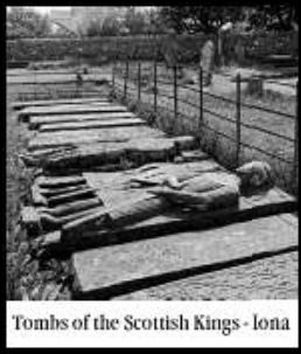
- There is some reason to believe that at an early date these Druid priests converted to the Christian faith forming a monastic order of the early Celtic Church known as the Culdees, which derives from the gaelic Culdich ("certain strangers") and the Latin Coli Dei meaning servants of the Lord or God. The 19th century antiquary, Godfrey Higgins, notes: "In the early history of the Christian church, in Britain and Ireland, we meet with an order of priests called Culdees....They had a very celebrated monastery in the island of Iona, and others in remote situations, and these situations, by accident or design, mostly the former possessions of the Druids....The result of all the enquiries which I have made into the history of the Culdees is, that they were the last remains of the Druids, who had been converted to Christianity, before the Roman church got any footing in Britain. They were Pythagorean Druidical monks, probably Essenes, and this accounts for their easily embracing Christianity: for the Essenes were as nearly Christians as possible." [sic] (The Celtic Druids, 1829)
- This is further supported by John Jamieson D.D. in his Historical Account of the Ancient Culdees of Iona (1811) who remarks: "There is, I am informed, a pretty general tradition in the highlands of Scotland, that the Culdees immediately succeeded the Druids, as the ministers of religion....The tradition that the Culdees succeeded the Druids at no great distance of time might seem to be supported by a circumstance of an interesting nature, which has been mentioned by several writers in our statistic accounts; that Clachan, the name still given in the Highlands to the place where a church stands, originally belonged to a Druidical temple."
This Celtic Culdee connection is commented on by the French oriental scholar, Henry Corbin, in The Imago Templi in Confrontation (1974) who says: "The primitive Celtic Church, prior to Romanization, is represented by groups of monks known as Culdees….The groups of companions called by this name seem, moreover, to have played a much larger role in Scotland than in Ireland….these autonomous groups of hermit brothers correspond to what we know of the original structure of the Celtic Church….these Coli Dei [Culdees] had a role to play on the Celtic side analogous to the role attributed on the eastern side….to the canons of the Holy Sepulchre, the spiritual descendants of the Essenes. The appeal to a distant Celto-Scottish filiation parallels the appeal made to affilitation with the builders of the Temple of Solomon and the community of Jerusalem. It is as if the double line of descent, Hierosolymitan and Scottish, linked, Ab origine symboli, the Church of James and the Celtic Church in the trials and misfortunes from which the Temple knighthood have to rescue them." Corbin continues: "The Coli Dei are also included in the spiritual line of descent from the builders of the Temple of Solomon, the line of the Essenes, the Gnostics, even the Manichaeans and the Ismailis. They were established at York in England, at Iona in Scotland, in Wales, and in Ireland; their favourite symbol was the dove, the feminine symbol of the Holy Spirit. In this context, it is not surprising to find Druidism intermingled with their tradition and the poems of Taliesin integrated to their corpus. The epic of the Round Table and the Quest of the Holy Grail have likewise been interpreted as referring to the rights of the Coli Dei. It was, moreover, to the time of the Coli Dei that is assigned the formation of the Scottish knighthood whose seat is typified by the mysterious sanctuary of Kilwinning, under the shadow of Mount Heredom in the extreme north of Scotland."
Commenting on the Druid and Culdee presence on Iona, a 19th century scottish travel writer, C.F. Gordon Cumming, observes: "What attraction it can have offered, to enduce the priests of the Sun to select it as their abode, it is hard to imagine, but, from time immemorial, it was known as the Sacred Isle of the Druids....It certainly is a strangely perplexing mystery, to find an insignificant little island, in this remote corner of the earth, exhorted to a position of such extraordinary honour....to anyone versed in the lore of the past, every corner of this Isle seems haunted by the spirits of Druids and Culdees....My favourite evening stroll was a solitary expedition across the moor towards the western side of this Isle, to the wildest rocky valley, where a small circle of stones is still dear to the islanders, as the Cappan Cuildich, or Tabernacle of the Culdees, for here, they say, it was, that the Standard of the Cross was first planted, and that the little band of Christians were wont to assemble in secret, to worship after the new fashion taught them by these strange Missionaries. The circle was, however, probably of older date still; its avenue of carefully-placed stones seems rather to belong to the buildings we call Druidic, and whether as temple or tomb, was probably associated with the earlier form of worship." (In the Hebrides, 1886)
The Cult of Columba
What Merlin knew, Columba only dreamed. But Columba’s monastery became a centre of pilgrimage. At first, access was restricted to high status pilgrims: royal and ecclesiastical visitors, or those in serious trouble, who stayed at its guest house, but later more humble pilgrims would have been allowed access to the monastery. - It is also reputed that the Culdees (Servants of the Lord) in the British Isles, including Iona where Columba preached; who were considered by the Roman Church to be a threat to them; had a secret book written by the Apostle John (probably the correct version of his Gospel which Columba included in the Book of Kells and his 3rd Book of Revelation).
The pilgrims travelled to Iona in life and in death. Many of the kings of Scotland, Ireland, and even of the Vikings, were buried there. Some of the most famous Kings of Alba, from Kenneth MacAlpine to MacBeth, made their final journey there - across the sound to Iona, onto the harbour, and up the Street of the Dead to the burial ground, the Relig Oran.
This royal tradition was only broken twice while The Western Isles stayed a part of the Kingdom of Alba - once by Constantine mac Aed ( buried St Andrews) and again by Malcolm Canmore (buried at Dunfermline). The last king to be interred on Iona was Malcolm’s brother, Donald Bane, before Malcolm’s son, Edgar, surrendered the island to Magnus, King of Norway, after he subdued the isles to his will in 1098 AD. Recently the tradition was revived, and Iona was again the centre of national mourning when the Labour leader, John Smith, was buried there.
Wealthy pilgrims brought money to the monastery, and in the 8th century some of the finest Dark Age works of art were created to glorify Columba. The Book of Kells, now held in Trintity College Dublin, was crafted on Iona, along with the celtic high crosses from the 8th and 9th centuries - dedicated to St Martin, St Odhrain, St John and St Matthew. The crosses are of exquisite celtic design and were given by wealthy patrons to promote the Cult of Columba.
In 794 AD Iona experienced the first of many Viking raids that eventually forced the monastery into decline. As one historian has commented: rich monasteries like Iona were the Dark Age equivalent of drive-in banks to the Vikings.
In 806 AD, a total of 68 monks were slain by the Vikings at Martyrs Bay, just south of the Ferry landing. By 825 AD the monastery, thanks to its exposed position, was virtually abandoned. St Blathmac refused to leave, and suffered martyrdom at the hands of Vikings for refusing to divulge the treasures and relics of Columba. In 849 AD Columba’s relics were removed and divided two ways between Scotland and Ireland.
Iona may have been abandoned, but in the 10th century its power was revived after the vikings converted to Christianity and intermarried with the local Gaelic populace. New building works began, such as St Oran’s Chapel, beside The Road of the Dead; and Margaret, Queen of Alba, made donations to promote the Cult of Columba.
In 1200 AD, Raghnall, son of Somerled, virtual King of the Isles, brought in the Benedictine Order and built the great abbey. He also established St Ronan’s Nunnery, named after one of Iona’s monks, which accomodated up to 400 Augustinian nuns - the ruins of this building still stand within the village. Raghnall's sister, Bethag, was instated as St Ronan’s first prioress.
The importation of Reformed Monastic Orders, like the Benedictines, to the heart of Columban monasticism wasn’t without controversy. The Bishop of Derry attacked the building works, but Raghnall prevailed and the abbey was completed. The Benedictines revitalised the Columban cult on Iona until the Reformation when the abbey was abandoned and slowly fell into ruin.
For just under 400 years the settlement lay in ruins until, in 1938, the Iona Community, a Ecumenical Christian group, was founded there by the Rev George MacLeod. Committed to finding the relevanceof the Gospel, they set about restoring the ruined abbey.
Templars of Iona
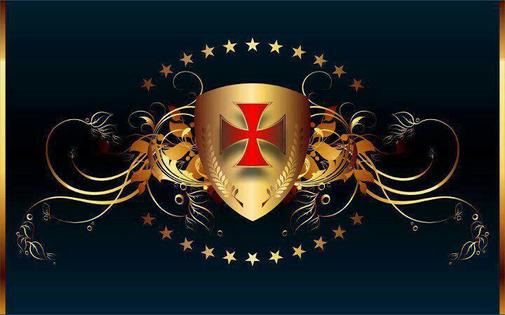
In the 14th century when the Knights Templar were destroyed by the King of France, remnant Templars sought refuge in Scotland under a King who swore no allegiance to the Catholic Pope. A small band of these Templars, several of which were Scottish in ancestry, were lead by the Order of the Labyrinth (a clandestine order of spiritual keepers of the catacombs and labyrinths of the world - Temple Doors #1-89) to Iona, a Holy Isle of Scotland. It was here that these Templars of a "lost order" began a service to the Light which took them beyond the veil of any Templars before them. They became aware of and enlightened in service to the TRUE "Templar" Order which had been established by John Martinus, the son of Yeshua and Mari Magdalene. The later Templars were but a shadow of this original order. The Iona Knights then, came full circle back into the most ancient origins of the "Johannes Templaris."
John Martinus had been raised on Iona by Ionian Priestess--left in their care by this mother, Mari. While still a youth, he was brought by the Priestess Elaine to Glastonbury to enter his initiations and study there. When the "lost" Knights came to Iona, they entered the sanctum of the Ionian Priestesses, a few of whom were still present on the isle at that time--yet in a state somewhat removed from the real-time world. Through a series of contacts through the Order of the Labyrinth, the Knights embarked upon a specific mission with the Ionian Priestesses--that of siring nine children--all daughters--who were born in the Avalonic realm. The purpose of this service was the re-genesis of the genetic balance of human-faery consciousness between these two earth domains. Prior to the role the Knights played in this pageant, the lineage which the Ionian Priestesses carried was coming to and end. What was instigated was a further perpetuation of that linage through space-time. In Avalon, since time is of a different relativity there than it is here, these nine women priestesses still exist. Merlin calls them the "MENSA."
Through the Order of the Labyrinth, the Templars on Iona were given the innermost doctrine and arcane knowledge of the Magii Initius Templari. This wisdom was contained within the Kro'Hahm'Ba, an ancient text from Persia, which contained pre-deluge Atlantean sacred knowledge. In this work, a prophetic document is given in which it is stated:
"From the loins of the Master Warriors will the Daughters of Sinn come forth. From the abode of the starry maze they shall enter the Mer (the gate into Avalon) and be there as one with the Great White Way."
The "Daughters of Sinn" refer to the priestesses of the Moon Goddess of Egypt, and was originally a name for women who were born to serve close to nature and able to traverse the parallel realties of the earth's natural realms. The "starry maze" is the geomantic zodiac of the heavens which is formed around the tor at Glastonbury.
The MENSA--the nine daughters of the Ionian Priestesses and the Knights Templars--engage in the Rite of Menhir, which is a ritual for raising the Old Earth consciousness from the center of the planet within the center of a living earth circle (the Menhir). There it becomes an "entity," which Merlin calls the "Magda." She is the Woman of Ancients, Mother of Sorrows, Grandmother of Graces.
The energy streaming from the resurrected Magda coincides with the full moon (in Avalonic time). It is analogous to menstrual blood, for it is released from the womb of the Ancient Earth to nourish a seed of the New World Consciousness. When that seed is not given forth into the matrix of the Menhir, the Magda discharges these vital energies into the Avalonic world. The "blood" is then nourishment for Avalonic forms, sustaining that world. Very few New Earth seeds are engendered in the Magda due to the strong magnetic presence of the Old World forms. It is for the Women of the Avalon Shield, through the RITE OF AVALON to build pathways for this "new seed" and protect its entrance into the Menhir. This is the crossing-over between the realms that will bring forth the Logos of the New World from the seed-pod of the Old. The CHRISTOS in that birthing Flame, which Yeshua hosted into the world, bringing it through the Sun Spirit and into the center of the Earth. This is the "child in the manger" with which the Women of the Avalon Shield will help to usher into the New Earth.
John Martinus had been raised on Iona by Ionian Priestess--left in their care by this mother, Mari. While still a youth, he was brought by the Priestess Elaine to Glastonbury to enter his initiations and study there. When the "lost" Knights came to Iona, they entered the sanctum of the Ionian Priestesses, a few of whom were still present on the isle at that time--yet in a state somewhat removed from the real-time world. Through a series of contacts through the Order of the Labyrinth, the Knights embarked upon a specific mission with the Ionian Priestesses--that of siring nine children--all daughters--who were born in the Avalonic realm. The purpose of this service was the re-genesis of the genetic balance of human-faery consciousness between these two earth domains. Prior to the role the Knights played in this pageant, the lineage which the Ionian Priestesses carried was coming to and end. What was instigated was a further perpetuation of that linage through space-time. In Avalon, since time is of a different relativity there than it is here, these nine women priestesses still exist. Merlin calls them the "MENSA."
Through the Order of the Labyrinth, the Templars on Iona were given the innermost doctrine and arcane knowledge of the Magii Initius Templari. This wisdom was contained within the Kro'Hahm'Ba, an ancient text from Persia, which contained pre-deluge Atlantean sacred knowledge. In this work, a prophetic document is given in which it is stated:
"From the loins of the Master Warriors will the Daughters of Sinn come forth. From the abode of the starry maze they shall enter the Mer (the gate into Avalon) and be there as one with the Great White Way."
The "Daughters of Sinn" refer to the priestesses of the Moon Goddess of Egypt, and was originally a name for women who were born to serve close to nature and able to traverse the parallel realties of the earth's natural realms. The "starry maze" is the geomantic zodiac of the heavens which is formed around the tor at Glastonbury.
The MENSA--the nine daughters of the Ionian Priestesses and the Knights Templars--engage in the Rite of Menhir, which is a ritual for raising the Old Earth consciousness from the center of the planet within the center of a living earth circle (the Menhir). There it becomes an "entity," which Merlin calls the "Magda." She is the Woman of Ancients, Mother of Sorrows, Grandmother of Graces.
The energy streaming from the resurrected Magda coincides with the full moon (in Avalonic time). It is analogous to menstrual blood, for it is released from the womb of the Ancient Earth to nourish a seed of the New World Consciousness. When that seed is not given forth into the matrix of the Menhir, the Magda discharges these vital energies into the Avalonic world. The "blood" is then nourishment for Avalonic forms, sustaining that world. Very few New Earth seeds are engendered in the Magda due to the strong magnetic presence of the Old World forms. It is for the Women of the Avalon Shield, through the RITE OF AVALON to build pathways for this "new seed" and protect its entrance into the Menhir. This is the crossing-over between the realms that will bring forth the Logos of the New World from the seed-pod of the Old. The CHRISTOS in that birthing Flame, which Yeshua hosted into the world, bringing it through the Sun Spirit and into the center of the Earth. This is the "child in the manger" with which the Women of the Avalon Shield will help to usher into the New Earth.
Seachd bliadhna 'n blr'ath
Thig muir air Eirinn re aon tr'ath
'S thar Ile ghuirm ghlais
Ach sn'amhaidh I Choluim Chl'eirich
The prophecy above tells that seven years before the day of judgment the ocean will sweep over both Ireland and Islay.
Yet the Isle of St Columba will swim above the waves.
Thig muir air Eirinn re aon tr'ath
'S thar Ile ghuirm ghlais
Ach sn'amhaidh I Choluim Chl'eirich
The prophecy above tells that seven years before the day of judgment the ocean will sweep over both Ireland and Islay.
Yet the Isle of St Columba will swim above the waves.
Heterodoxy, St. Columba & Iona
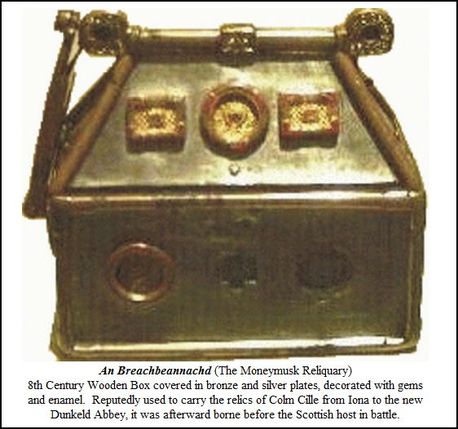
Within the Celtic Church of the Dark Ages (in the days of Taliesin and the Merlin seers to the kings), there had been some very prominent adepts of the old wisdom: abbots and culdees such as St David, St Patrick and St Columba, all of whom were denounced in their day by the Roman Church for their so-called wizardry and pagan beliefs. Even the later papal establishment regarded them all as necromancers and sorcerers, but this is not the way things are currently portrayed. Although the Merlin prophecies were expressly banned by the Council of Trento, the teachings of David, Patrick and Columba were so firmly cemented in society that the Church pursued a different strategy of incorporation.
A thousand years after the lifetimes of these Druidic Magi, the Vatican elected to bring them into the orthodox saintly fold so that the real truth of their Celtic environment would be overshadowed. Then, only a couple of years ago, the British Post Office and the Anglican Church joined forces to promote the gentle St Columba of the Celts alongside his bitter Catholic rival, St Augustine of Rome, who came to England with an express papal brief to destroy the Columban movement immediately after Columba's death in 597.
Notwithstanding this historical fact, however, the anniversary postage stamps and substantially hyped propagandist material of 1997 portrayed these two arch-enemies as if they had been blood brothers in a common cause - proving beyond doubt that new myths of "churchianity" are still being created to this day.
Even though many Highland clans supported the Celtic Church, over time, other well known examples of their involvement which conflicted with feudal and Catholic practice were victims of the changing order in Scotland. Constantine and Gillemichael MacDuff, first two known chiefs of Clan MhiccDuff, earls of Fife in the 12th Century, of the Kindred of Saint Columba, sons of the last hereditary abbot of Dunkeld and their heirs, held the vested right of leading the Scottish host in battle. It seems probable that this right derived from that of bearing the royal "vexillum" (originally a reliquary of Saint Columba called the "Breachbeannachd," (Spotted Blessing or Benediction) and later a consecrated heraldic banner), honors resulting from their ancestors’ positions in the Celtic Church. Early Christian manuscripts and other relics were kept in a shrine or satchel known in Old Irish as a "tiag," often richly decorated with gold and gems. Their care and custody was an important and coveted office. In 1211, the MhiccDuff honors were delegated by King William The Lion to the Norman Scrymgeours, relatives by marriage of the MhiccDuff and abbots of Arbroath, who supported the crown and held charters from both Wallace and Bruce as hereditary Constables of Dundee and bearers of the "vexillum regium" or Royal Banner of Scotland. The armies of the Gael had traditionally been led into battle by a Celtic abbot carrying a sacred reliquary or "vexillum," an honor now preempted by a Norman. The Monymusk Reliquary was used to bless Robert Bruce’s army before The Battle of Bannockburn in 1314.
The Norman kings of England and Scotland were the primary sponsors of the hypocritical argument that the Celtic Church was corrupted by the independent proprietary secular abbots of the Scottish and Irish monasteries and should be brought under the Augustinian rule of the bishops. Alexander I attempted to found an Augustinian priory at St Andrews beside the Culdee community there, beginning in 1144. The crown argued fallaciously that canons should replace Culdees because both could serve parishes. After twenty years of effort, the king’s attempt to convey the Culdees’ property to the Augustinians was a failure. But at Lochleven, the king threatened expulsion for those clerics who would not submit to Augustinian canon, that is, live "regulariter" (according to the rule). Thereafter, Lochleven became a priory dependent on the Augustinians of St Andrews. In the 13th Century, larger monasteries of up to forty monks such as Glenluce, Cundrennan and Kilwinning were created in the west in competition with existing Celtic venues. By 1286, the Dominicans, or Blackfriars, had at least twelve houses in Scotland; the friars minor (Franciscans or gray friars) had six; and the Carmelites or Whitefriars, three. Anglophiles and Catholics characterize the Scottish Church of this period as stagnant. In reality, the tradition of the Scots had been suppressed by the government, forced to simmer quietly until brought to a boil by the Reformation.
Restored Cross of Saint John, Iona
In 1164, after King Somhairle MacGillebruide of The South Isles had defeated the King of Norway to create the kingdom, he traveled to Ireland to invite Flaithberrach, Irish Chief Co-Arb of St Columba’s Order at Daire, to accept the abbacy of Iona. The importance that Somhairle imparted to the mission is witnessed by the deputation he took with him, which consisted of the principle religious leaders of his kingdom; Augustine, Arch Bishop of The Isles; MacDubhsidh, Lector of Iona; the Holy Hermit MacGilleduibhe; and MacForchellaig, Head of the Céli Dé at Saddell. His request was in vain, for the saint’s kindred in Ireland would not allow the Columban primacy to pass back to the Hebrides, effectively ending the Columban Order’s association with Iona, although they did try to maintain it. The Annals of Ulster show visits by members of the Order to Iona in 1174, 1188 and 1200. But the buildings on Iona were falling into ruin and the burial place of Scottish kings had become a disgrace. Finally, Somhairle’s son Ranald, after succeeding to the lordship, followed the Scottish kings’ examples and, in order to preempt action by the crown as much as for any other reason, in 1203, obtained a commission from King Malcolm and Queen Margaret and introduced a Benedictine order under a "minster" (mother) house, probably Dunkeld, according to "Ordericus Vitalis." But when Queen Margaret funded the restoration, the Kindred of Saint Columba, now headquartered at Daire, lost control of their Mother House at Iona. Ranald also established a Benedictine convent and made his sister Beatrice the first prioress, on an island where Colm Cille had expressly forbidden women to set foot.
St. Columba
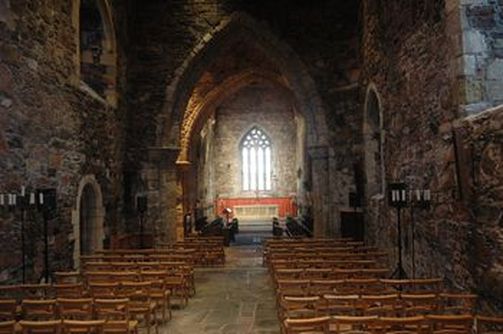
Extension of the Celtic Church in Ireland
My Irish lineage is of the clan of Geohegan of Meath and Kings County from my mother Sylvia d. of William Padget son of James Padget m. Jane Geohegan d. of William Geohegan of Kiama, s. of Laurence Geohegan of Scarborough England great great great grandson of Charles Geoghegan of Ireland direct descendant of Eohegan or “Little Horse”, 3rd son of Neill of the Nine Hostages. The lineage is on the Abrahams Legacy site at www.abrahams-legacy.org/geoghegans.html.
The lineage of Neill is important because at least 5% of the entire population of Ireland is directly descended from him, not to mention the Scots and many English families who are also descended from his ancestors as well. Thus an incredible number of Irish share this lineage and, as we will see, also a relationship to the House of David.
Neill was a warrior in Ireland who had a number of wives and concubines. He was declared High King in Ireland at Tara. He invaded Britain and renamed Alba as Scotland, after the Milesian ancestress Scota. The original Scota was a princess of the 18th Ahmosid dynasty of Egypt and she, with her husband Niul and her son Gaodhal Glas (from whom the Gadelians are named), crossed the Red Sea with Moses in the Mixed Multitude. Niul had been given the land of Campus Cyrunt and the pharaoh’s daughter’s hand in marriage because of his efforts in the Nubian wars in the South. Their loyalty to Israel saw them persecuted by Egypt and they had to leave the lands given to them by the preceding pharaoh.
To return to Neill of the Nine Hostages, his family had established the Dal Riata Scots as we will see below.
After invading Britain, Neill then invaded Europe and was almost responsible for expelling the Romans from Gaul. He took 200 captives in chains to Ireland. He himself was later murdered by the son of the king of Leinster. One of the 200 slaves/prisoners was a man named Patrick of Tours, nephew or son of Martyn of Tours (accounts vary depending on denomination; the Martyn line of Devon above is also descended from this family in the Norman Conquest of 1066 with Baron Martyn of Tours). Patrick paid Neill back by converting his great great grandson to the Christian Faith. That grandson was named (in the English) Columba. He became the great Sabbatarian Saint Columba of Iona and went on to consolidate the Christian Faith among the Irish Celts and Scots. He was the greatest Sabbatarian Churchman of the Celts. He went on to train those such as Aiden of Lindisfarne and the Sabbatarian Church was developed further through them, even though the councils saw the Celtic Church falter and virtually go underground after 664 CE at Whitby.
St. COLUMBA : Abbot of Iona, b. at Garten, County Donegal, Ireland, 7 December, 521; d. 9 June, 597.
His earliest biographer Adamnan attributes supernatural powers to St. Columba, including curing diseases, driving away demons, controlling wild animals, calming stormy seas, turning water to wine for Mass, mending broken bones, ripening grain, even raising the dead. as well as powerful prayers, prophecies, and clairvoyance ("second sight") or remote viewing. ,
He belonged to the Clan O'Donnell, and was of royal descent. His father's name was Fedhlimdh and that of his mother Eithne. On his father's side he was great-great-grandson of Niall of the Nine Hostages, an Irish king of the fourth century. His baptismal name was Colum, which signifies a dove, hence the latinized form Columba. It assumes another form in Colum-cille, the suffix meaning "of the Churches". He was baptizedat Tulach-Dubhglaise, now Temple-Douglas, by a priest named Cruithnechan, who afterwards became his tutor or foster-father. When sufficiently advanced in letters he entered the monastic school of Moville under St. Finnian who had studied at St. Ninian's "Magnum Monasterium" on the shores of Galloway. Columba at Moville monastic life and received the diaconate. In the same place his sanctityfirst manifested itself by miracles. By his prayers, tradition says, he converted water into wine for the Holy Sacrifice (Adam., II, i). Having completed his training at Moville, he travelled southwards into Leinster, where he became a pupil of an aged bard named Gemman. On leaving him, Columba entered the monastery of Clonard, governed at that time by Finnian, a remarkable, like his namesake of Moville, for sanctity and learning. Here he imbibed the traditions of the Welsh Church, for Finnian had been trained in the schools of St. David. Here also he became one those twelve Clonard disciples known in subsequent history as the Twelve Apostles of Ireland. About this same time he was promoted to the priesthood by Bishop Etchen of Clonfad. The story that St. Finnian wished Columba to be consecrated bishop, but through a mistake only priest's orders were conferred, is regarded by competent authorities as the invention of a later age (Reeves, Adam., 226).
Another preceptor of Columba was St. Mobhi, whose monastery at Glasnevin was frequented by such famous men as St. Canice, St. Comgall, and St. Ciaran. A pestilence which devastated Ireland in 544 caused the dispersion of Mobhi's disciples, and Columba returned to Ulster, the land of his kindred. The following years were marked by the foundation of several important monasteries, Derry, Durrow, and Kells. Derry and Durrow were always specially dear to Columba. While at Derry it is said that he planned a pilgrimage to Rome and Jerusalem, but did not proceed farther than Tours. Thence he brought a copy of those gospels that had lain on the bosom of St. Martin for the space of 100 years. This relic was deposited in Derry (Skene, Celtic Scotland, II, 483). Columba left Ireland and passed over into Scotland in 563. The motives for this migration have been frequently discussed. Bede simply says: "Venit de Hibernia . . . praedicaturus verbum Dei" (H. E., III, iv); Adarnnan: "pro Christo perigrinari volens enavigavit" (Praef., II). Later writers state that his departure was due to the fact that he had induced the clan Neill to rise and engage in battle against King Diarmait at Cooldrevny in 561. The reasons alleged for this action of Columba are: (1) The king's violation of the right of sanctuary belonging to Columba's person as a monk the occasion of the murder of Prince Curnan, the saint's kinsman; (2) Diarmait's adverse judgment concerning the copy Columba had secretly made of St. Finnian's psalter. Columba is said to have supported by his prayers the men of the North who were fighting while Finnian did the same for Diarmait's men. The latter were defeated with a loss of three thousand. Columba's conscience smote him, and he had recourse to his confessor, St. Molaise, who imposed this severe penance: to leave Ireland and preach the Gospel so as to gain as many souls to Christ as lives lost at Cooldrevny, and never more to look upon his native land. Some writers hold that these are legends invented by the bards and romancers of a later age, because there is no mention of them by the earliest authorities (O'Hanlon, Lives of the Ir. Saints, VI, 353). Cardinal Moran accepts no other motive than that assigned by Adamnan, "a desire to carry the Gospel to a pagan souls to God". (Lives of Irish Saints in Great Britain, 67). Archbishop Healy, on the contrary, considers that the saint did incite to battle, and exclaims: "O felix culpa . . . which produced so much good both for Erin and Alba (Schools and Scholars, 311).
Iona Columba was in his forty-fourth year when he departed from Ireland. He and his twelve companions crossed the sea in a currach of wickerwork covered with hides. They landed at Iona on the eve of Pentecost, 12 May, 563. The island, according to Irish authorities, was granted to the monastic colonists by King Conall of Dalriada, Columba's kinsman. Bede attributes the gift to the Picts (Fowler, p. lxv). It was a convenient situation, being midway between his countrymen along the western coast and the Picts of Caledonia. He and his brethren proceeded at once to erect their humble dwellings, consisting of a church, refectory, and cells, constructed of wattles and rough planks. After spending some years among the Scots of Dalriada, Columba began the great work of his life, the conversion of the Northern Picts. Together with St. Comgall and St. Canice (Kenneth) he visited King Brude in his royal residence near Inverness. Admittance was refused to the missionaries, and the gates were closed and bolted, but before the sign of the cross the bolts flew back, the doors stood open, and the monks entered the castle. Awe-struck by so evident a miracle, the king listened to Columba with reverence; and was baptized. The people soon followed the example set them, and thus was inaugurated a movement that extended itself to the whole of Caledonia. Opposition was not wanting, and it came chiefly from the Druids, who officially represented the paanism of the nation.
The thirty-two remaining years of Columba's life were mainly spent in preaching the Christian Faith to the inhabitants of the glens and wooded straths of Northern Scotland. His steps can be followed not only through the Great Glen, but eastwards also, into Aberdeenshire. The "Book of Deer" (p. 91) tells us how he and Drostan came, as God had shown them to Aberdour in Buchan, and how Bede, a Pict, who was high steward of Buchan, gave them the town in freedom forever. The preaching of the saint was confirmed by many miracles, and he provided for the instruction of his converts by the erection of numerous churches and monasteries. One of his journeys brought him to Glasgow, where he met St. Mungo, the apostle of Strathclyde. He frequently visited Ireland; in 570 he attended the synod of Drumceatt, in company with the Scottish King Aidan, whom shortly before he had inaugurated successor of Conall of Dalriada. When not engaged in missionary journeys, he always resided at Iona. Numerous strangers sought him there, and they received help for soul and body. From Iona he governed those numerous communities in Ireland and Caledonia, which regarded him as their father and founder. This accounts for the unique position occupied by the successors of Columba, who governed the entire province of the Northern Picts although they had received priest's orders only. It was considered unbecoming that any successor in the office of Abbott of Iona should possess a dignity higher than of the founder. The bishops were regarded as being of a superior order, but subject nevertheless to the jurisdiction of the abbot. At Lindisfarne the monks reverted to the ordinary law and were subject to a bishop (Bede, H.E., xxvii).
Columba is said never to have spent an hour without study, prayer, or similar occupations. When at home he was frequently engaged in transcribing. On the eve of his death he was engaged in the work of transcription. It is stated that he wrote 300 books with his own hand, two of which, "The Book of Durrow" and the psalter called "The Cathach", have been preserved to the present time. The psalter enclosed in a shrine, was originally carried into battle by the O'Donnells as a pledge of victory. Several of his compositions in Latin and Irish have come down to us, the best known being the poem "Altus Prosator", published in the "Liber Hymnorum", and also in another form by the late Marquess of Bute. There is not sufficient evidence to prove that the rule attributed to him was really his work.
In the spring of 597 he knew that his end was approaching. On Saturday, 8 June, he ascended the hill overlooking his monastery and blessed for the last time the home so dear to him. That afternoon he was present at Vespers, and later, when the bell summoned the community to the midnight service, he forestalled the others and entered the church without assistance. But he sank before the altar, and in that place breathed forth his soul to God, surrounded by his disciples. This happened a little after midnight between the 8th and 9th of June, 597. He was in the seventy-seventh year of his age. The monks buried him within the monastic enclosure. After the lapse of a century or more his bones were disinterred and placed within a suitable shrine. But as Northmen and Danes more than once invaded the island, the relics Ireland and deposited in the church of Downpatrick. Since the twelfth century history is silent regarding them. His books and garments were held in veneration at Iona, they were exposed and carried in procesison, and were the means of working miracles (Adam., II, xlv). His feast is kept in Scotland and Ireland on the 9th of June. In the Scottish Province of st Andrews and Edinburgh there is a Mass and Office proper to the festival, which ranks as a double of the second class with an octave. He is patron of two Scottish dioceses Argyle and the Isles and Dunkeld. According to tradition St. Columba was tall and of dignified mien. Adamnan says: "He was angelic in appearance, graceful in speech, holy in work" (Praef., II). His voice was strong, sweet, and sonorous capable at times of being heard at a great distance. He inherited the ardent temperament and strong passions of his race. It has been sometimes said that he was of an angry and vindictive spirit not only because of his supposed part in the battle of Cooldrevny but also because of irritant related by Adamnan (II, xxiii sq.) But the deeds that roused his indignation were wrongs done to others, and the retribution that overtook the perpetrators was rather predicted than actually invoked. Whatever faults were inherent in his nature he overcame and he stands before the world conspicuous for humility and charity not only towards has brethren, but towards strangers also. He was generous and warm-hearted, tender and kind even to dumb creatures. He was ever ready to sympathize with the joys and sorrows of others. His fasts and vigils were carried to a great extent. The stone pillow on which he slept is said to be still preserved in Iona. His chastity of body and purity of mind are extolled by all his biographers. Notwithstanding his wonderful austerities, Adamnan assures us he was beloved by all, "for a holy joyousness that ever beamed from his countenance revealed the gladness with which the Holy Spirit filled his soul". (Praef., II.)
Influence, and attitude towards Rome He was not only a great missionary saint who won a whole kingdom to Christ, but he was a statesman, a scholar, a poet, and the founder of numerous churches and monasteries. His name is dear to Scotsmen and Irishmen alike. And because of his great and noble work even non-Catholics hold his memory in veneration. For the purposes of controversy it has been maintained some that St. Columba ignored papal supremacy, because he entered upon his mission without the pope's authorization. Adamnan is silent on the subject; but his work is neither exhaustive as to Columba's life, nor does it pretend to catalogue the implicit and explicit belief of his patron. Indeed, in those days a mandate from the pope was not deemed essential for the work which St. Columba undertook.
My Irish lineage is of the clan of Geohegan of Meath and Kings County from my mother Sylvia d. of William Padget son of James Padget m. Jane Geohegan d. of William Geohegan of Kiama, s. of Laurence Geohegan of Scarborough England great great great grandson of Charles Geoghegan of Ireland direct descendant of Eohegan or “Little Horse”, 3rd son of Neill of the Nine Hostages. The lineage is on the Abrahams Legacy site at www.abrahams-legacy.org/geoghegans.html.
The lineage of Neill is important because at least 5% of the entire population of Ireland is directly descended from him, not to mention the Scots and many English families who are also descended from his ancestors as well. Thus an incredible number of Irish share this lineage and, as we will see, also a relationship to the House of David.
Neill was a warrior in Ireland who had a number of wives and concubines. He was declared High King in Ireland at Tara. He invaded Britain and renamed Alba as Scotland, after the Milesian ancestress Scota. The original Scota was a princess of the 18th Ahmosid dynasty of Egypt and she, with her husband Niul and her son Gaodhal Glas (from whom the Gadelians are named), crossed the Red Sea with Moses in the Mixed Multitude. Niul had been given the land of Campus Cyrunt and the pharaoh’s daughter’s hand in marriage because of his efforts in the Nubian wars in the South. Their loyalty to Israel saw them persecuted by Egypt and they had to leave the lands given to them by the preceding pharaoh.
To return to Neill of the Nine Hostages, his family had established the Dal Riata Scots as we will see below.
After invading Britain, Neill then invaded Europe and was almost responsible for expelling the Romans from Gaul. He took 200 captives in chains to Ireland. He himself was later murdered by the son of the king of Leinster. One of the 200 slaves/prisoners was a man named Patrick of Tours, nephew or son of Martyn of Tours (accounts vary depending on denomination; the Martyn line of Devon above is also descended from this family in the Norman Conquest of 1066 with Baron Martyn of Tours). Patrick paid Neill back by converting his great great grandson to the Christian Faith. That grandson was named (in the English) Columba. He became the great Sabbatarian Saint Columba of Iona and went on to consolidate the Christian Faith among the Irish Celts and Scots. He was the greatest Sabbatarian Churchman of the Celts. He went on to train those such as Aiden of Lindisfarne and the Sabbatarian Church was developed further through them, even though the councils saw the Celtic Church falter and virtually go underground after 664 CE at Whitby.
St. COLUMBA : Abbot of Iona, b. at Garten, County Donegal, Ireland, 7 December, 521; d. 9 June, 597.
His earliest biographer Adamnan attributes supernatural powers to St. Columba, including curing diseases, driving away demons, controlling wild animals, calming stormy seas, turning water to wine for Mass, mending broken bones, ripening grain, even raising the dead. as well as powerful prayers, prophecies, and clairvoyance ("second sight") or remote viewing. ,
He belonged to the Clan O'Donnell, and was of royal descent. His father's name was Fedhlimdh and that of his mother Eithne. On his father's side he was great-great-grandson of Niall of the Nine Hostages, an Irish king of the fourth century. His baptismal name was Colum, which signifies a dove, hence the latinized form Columba. It assumes another form in Colum-cille, the suffix meaning "of the Churches". He was baptizedat Tulach-Dubhglaise, now Temple-Douglas, by a priest named Cruithnechan, who afterwards became his tutor or foster-father. When sufficiently advanced in letters he entered the monastic school of Moville under St. Finnian who had studied at St. Ninian's "Magnum Monasterium" on the shores of Galloway. Columba at Moville monastic life and received the diaconate. In the same place his sanctityfirst manifested itself by miracles. By his prayers, tradition says, he converted water into wine for the Holy Sacrifice (Adam., II, i). Having completed his training at Moville, he travelled southwards into Leinster, where he became a pupil of an aged bard named Gemman. On leaving him, Columba entered the monastery of Clonard, governed at that time by Finnian, a remarkable, like his namesake of Moville, for sanctity and learning. Here he imbibed the traditions of the Welsh Church, for Finnian had been trained in the schools of St. David. Here also he became one those twelve Clonard disciples known in subsequent history as the Twelve Apostles of Ireland. About this same time he was promoted to the priesthood by Bishop Etchen of Clonfad. The story that St. Finnian wished Columba to be consecrated bishop, but through a mistake only priest's orders were conferred, is regarded by competent authorities as the invention of a later age (Reeves, Adam., 226).
Another preceptor of Columba was St. Mobhi, whose monastery at Glasnevin was frequented by such famous men as St. Canice, St. Comgall, and St. Ciaran. A pestilence which devastated Ireland in 544 caused the dispersion of Mobhi's disciples, and Columba returned to Ulster, the land of his kindred. The following years were marked by the foundation of several important monasteries, Derry, Durrow, and Kells. Derry and Durrow were always specially dear to Columba. While at Derry it is said that he planned a pilgrimage to Rome and Jerusalem, but did not proceed farther than Tours. Thence he brought a copy of those gospels that had lain on the bosom of St. Martin for the space of 100 years. This relic was deposited in Derry (Skene, Celtic Scotland, II, 483). Columba left Ireland and passed over into Scotland in 563. The motives for this migration have been frequently discussed. Bede simply says: "Venit de Hibernia . . . praedicaturus verbum Dei" (H. E., III, iv); Adarnnan: "pro Christo perigrinari volens enavigavit" (Praef., II). Later writers state that his departure was due to the fact that he had induced the clan Neill to rise and engage in battle against King Diarmait at Cooldrevny in 561. The reasons alleged for this action of Columba are: (1) The king's violation of the right of sanctuary belonging to Columba's person as a monk the occasion of the murder of Prince Curnan, the saint's kinsman; (2) Diarmait's adverse judgment concerning the copy Columba had secretly made of St. Finnian's psalter. Columba is said to have supported by his prayers the men of the North who were fighting while Finnian did the same for Diarmait's men. The latter were defeated with a loss of three thousand. Columba's conscience smote him, and he had recourse to his confessor, St. Molaise, who imposed this severe penance: to leave Ireland and preach the Gospel so as to gain as many souls to Christ as lives lost at Cooldrevny, and never more to look upon his native land. Some writers hold that these are legends invented by the bards and romancers of a later age, because there is no mention of them by the earliest authorities (O'Hanlon, Lives of the Ir. Saints, VI, 353). Cardinal Moran accepts no other motive than that assigned by Adamnan, "a desire to carry the Gospel to a pagan souls to God". (Lives of Irish Saints in Great Britain, 67). Archbishop Healy, on the contrary, considers that the saint did incite to battle, and exclaims: "O felix culpa . . . which produced so much good both for Erin and Alba (Schools and Scholars, 311).
Iona Columba was in his forty-fourth year when he departed from Ireland. He and his twelve companions crossed the sea in a currach of wickerwork covered with hides. They landed at Iona on the eve of Pentecost, 12 May, 563. The island, according to Irish authorities, was granted to the monastic colonists by King Conall of Dalriada, Columba's kinsman. Bede attributes the gift to the Picts (Fowler, p. lxv). It was a convenient situation, being midway between his countrymen along the western coast and the Picts of Caledonia. He and his brethren proceeded at once to erect their humble dwellings, consisting of a church, refectory, and cells, constructed of wattles and rough planks. After spending some years among the Scots of Dalriada, Columba began the great work of his life, the conversion of the Northern Picts. Together with St. Comgall and St. Canice (Kenneth) he visited King Brude in his royal residence near Inverness. Admittance was refused to the missionaries, and the gates were closed and bolted, but before the sign of the cross the bolts flew back, the doors stood open, and the monks entered the castle. Awe-struck by so evident a miracle, the king listened to Columba with reverence; and was baptized. The people soon followed the example set them, and thus was inaugurated a movement that extended itself to the whole of Caledonia. Opposition was not wanting, and it came chiefly from the Druids, who officially represented the paanism of the nation.
The thirty-two remaining years of Columba's life were mainly spent in preaching the Christian Faith to the inhabitants of the glens and wooded straths of Northern Scotland. His steps can be followed not only through the Great Glen, but eastwards also, into Aberdeenshire. The "Book of Deer" (p. 91) tells us how he and Drostan came, as God had shown them to Aberdour in Buchan, and how Bede, a Pict, who was high steward of Buchan, gave them the town in freedom forever. The preaching of the saint was confirmed by many miracles, and he provided for the instruction of his converts by the erection of numerous churches and monasteries. One of his journeys brought him to Glasgow, where he met St. Mungo, the apostle of Strathclyde. He frequently visited Ireland; in 570 he attended the synod of Drumceatt, in company with the Scottish King Aidan, whom shortly before he had inaugurated successor of Conall of Dalriada. When not engaged in missionary journeys, he always resided at Iona. Numerous strangers sought him there, and they received help for soul and body. From Iona he governed those numerous communities in Ireland and Caledonia, which regarded him as their father and founder. This accounts for the unique position occupied by the successors of Columba, who governed the entire province of the Northern Picts although they had received priest's orders only. It was considered unbecoming that any successor in the office of Abbott of Iona should possess a dignity higher than of the founder. The bishops were regarded as being of a superior order, but subject nevertheless to the jurisdiction of the abbot. At Lindisfarne the monks reverted to the ordinary law and were subject to a bishop (Bede, H.E., xxvii).
Columba is said never to have spent an hour without study, prayer, or similar occupations. When at home he was frequently engaged in transcribing. On the eve of his death he was engaged in the work of transcription. It is stated that he wrote 300 books with his own hand, two of which, "The Book of Durrow" and the psalter called "The Cathach", have been preserved to the present time. The psalter enclosed in a shrine, was originally carried into battle by the O'Donnells as a pledge of victory. Several of his compositions in Latin and Irish have come down to us, the best known being the poem "Altus Prosator", published in the "Liber Hymnorum", and also in another form by the late Marquess of Bute. There is not sufficient evidence to prove that the rule attributed to him was really his work.
In the spring of 597 he knew that his end was approaching. On Saturday, 8 June, he ascended the hill overlooking his monastery and blessed for the last time the home so dear to him. That afternoon he was present at Vespers, and later, when the bell summoned the community to the midnight service, he forestalled the others and entered the church without assistance. But he sank before the altar, and in that place breathed forth his soul to God, surrounded by his disciples. This happened a little after midnight between the 8th and 9th of June, 597. He was in the seventy-seventh year of his age. The monks buried him within the monastic enclosure. After the lapse of a century or more his bones were disinterred and placed within a suitable shrine. But as Northmen and Danes more than once invaded the island, the relics Ireland and deposited in the church of Downpatrick. Since the twelfth century history is silent regarding them. His books and garments were held in veneration at Iona, they were exposed and carried in procesison, and were the means of working miracles (Adam., II, xlv). His feast is kept in Scotland and Ireland on the 9th of June. In the Scottish Province of st Andrews and Edinburgh there is a Mass and Office proper to the festival, which ranks as a double of the second class with an octave. He is patron of two Scottish dioceses Argyle and the Isles and Dunkeld. According to tradition St. Columba was tall and of dignified mien. Adamnan says: "He was angelic in appearance, graceful in speech, holy in work" (Praef., II). His voice was strong, sweet, and sonorous capable at times of being heard at a great distance. He inherited the ardent temperament and strong passions of his race. It has been sometimes said that he was of an angry and vindictive spirit not only because of his supposed part in the battle of Cooldrevny but also because of irritant related by Adamnan (II, xxiii sq.) But the deeds that roused his indignation were wrongs done to others, and the retribution that overtook the perpetrators was rather predicted than actually invoked. Whatever faults were inherent in his nature he overcame and he stands before the world conspicuous for humility and charity not only towards has brethren, but towards strangers also. He was generous and warm-hearted, tender and kind even to dumb creatures. He was ever ready to sympathize with the joys and sorrows of others. His fasts and vigils were carried to a great extent. The stone pillow on which he slept is said to be still preserved in Iona. His chastity of body and purity of mind are extolled by all his biographers. Notwithstanding his wonderful austerities, Adamnan assures us he was beloved by all, "for a holy joyousness that ever beamed from his countenance revealed the gladness with which the Holy Spirit filled his soul". (Praef., II.)
Influence, and attitude towards Rome He was not only a great missionary saint who won a whole kingdom to Christ, but he was a statesman, a scholar, a poet, and the founder of numerous churches and monasteries. His name is dear to Scotsmen and Irishmen alike. And because of his great and noble work even non-Catholics hold his memory in veneration. For the purposes of controversy it has been maintained some that St. Columba ignored papal supremacy, because he entered upon his mission without the pope's authorization. Adamnan is silent on the subject; but his work is neither exhaustive as to Columba's life, nor does it pretend to catalogue the implicit and explicit belief of his patron. Indeed, in those days a mandate from the pope was not deemed essential for the work which St. Columba undertook.
